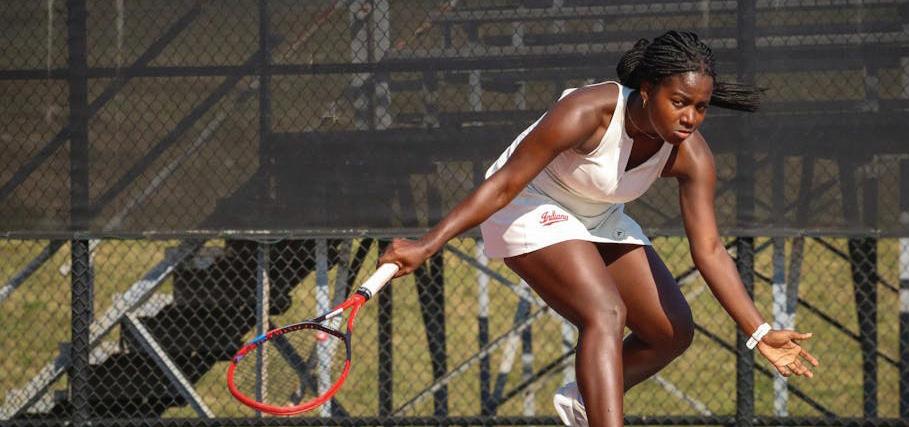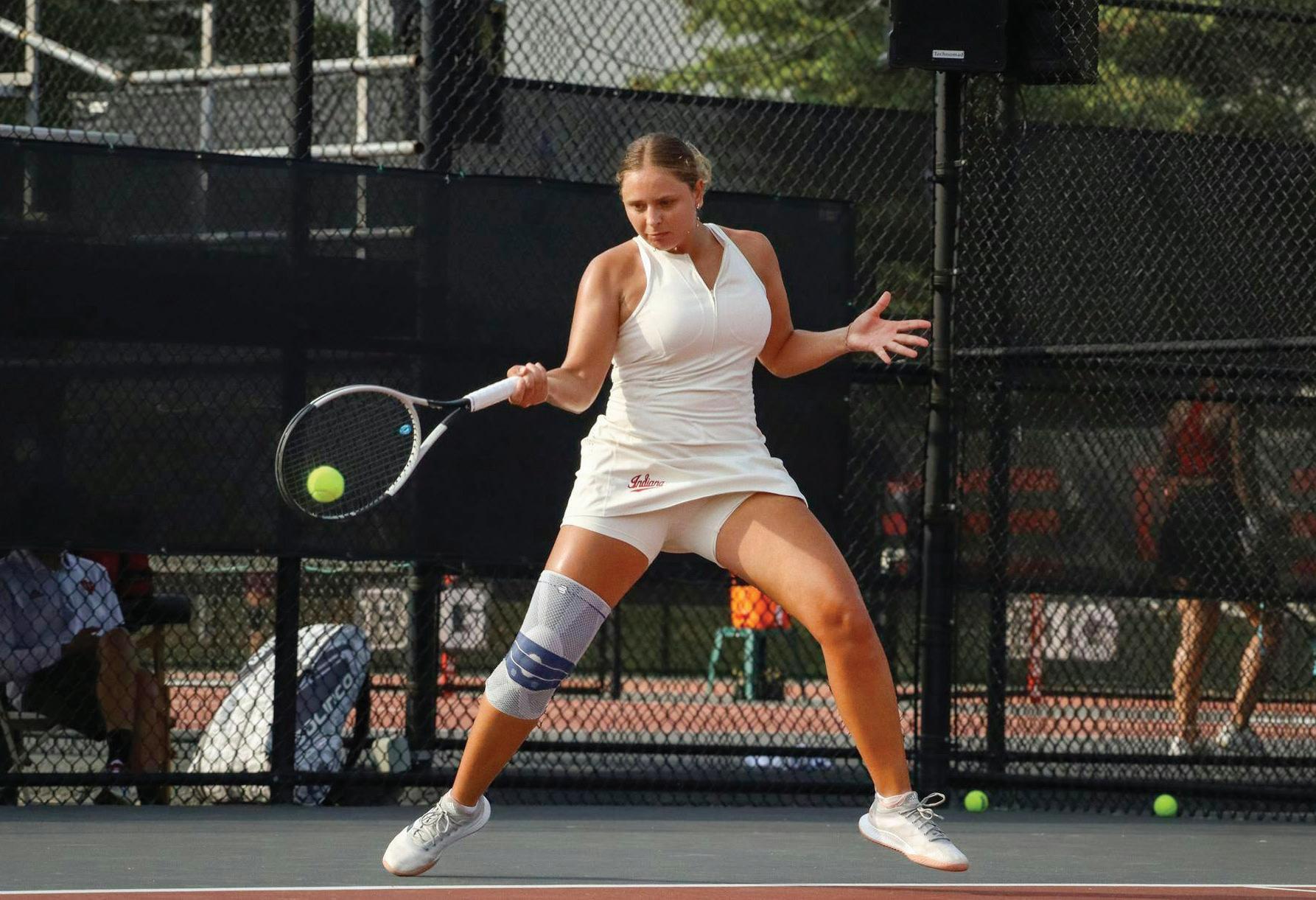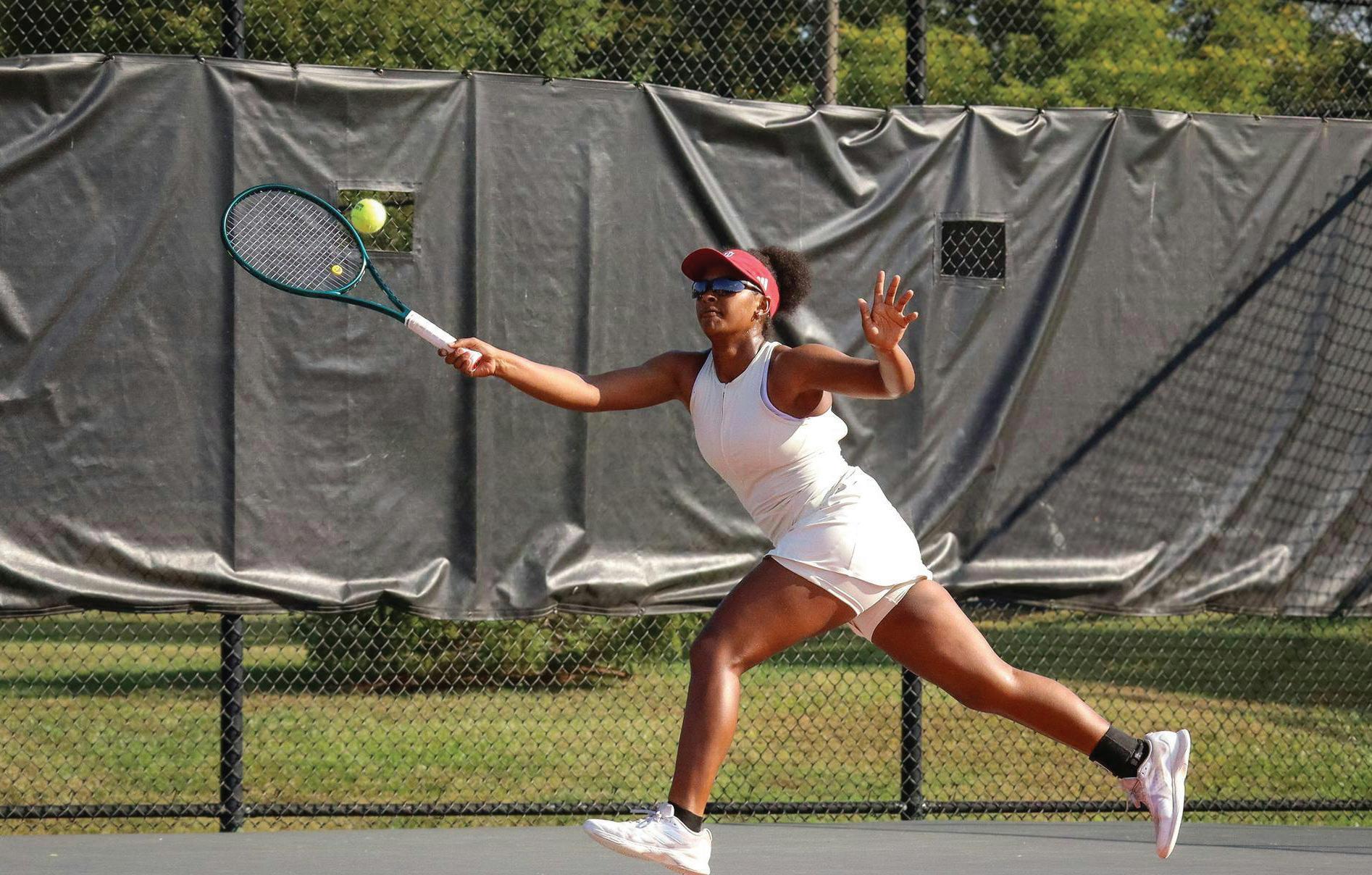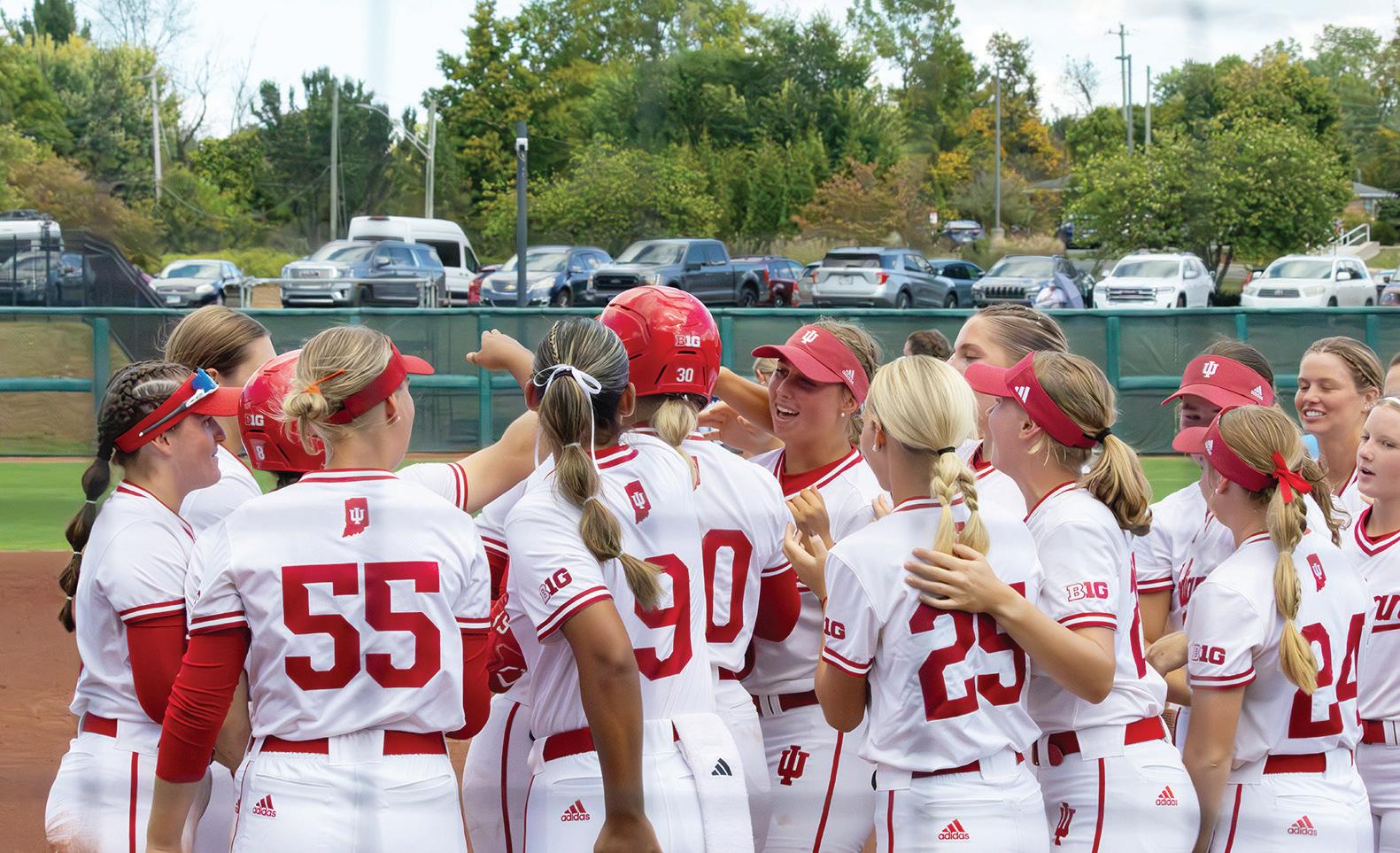IDS



By Deshna Venkatachalam devenkat@iu.edu
IU sophomore Yotam Krikov
woke up the morning of Oct. 7, 2023, in Jerusalem to the sounds of sirens. He joked they were being bombed, but a few minutes later, he and 236 other students in his gap-year program were rushed to a bomb shelter.
Two years later, Krikov and around 150 others walked up the candlelit stairs of IU Hillel to the second floor. Together, they held small Israeli flags as they mourned and remembered the victims of the attack at a vigil hosted by IU Hillel, home of the Jewish Culture Center.
On Oct. 7, 2023, a Hamasled attack left nearly 1,200 people in Israel dead and 251 taken hostage. An additional four individuals had been taken hostage prior to the attack, bringing the total number of hostages to 255.
According to the Associated Press, 148 hostages have been returned or rescued alive, and the bodies of 59 have been recovered. As of Oct. 7, 2025, 48 hostages remain in captivity, with 20 believed to still be alive. In response to the initial attack, the Israeli military began a ground invasion later that month. The IsraelHamas war is still ongoing with ceasefire negotiations underway.
The dining room of the first floor of Hillel displayed pictures of the 251 hostages. Underneath the photos were the words “bring him/ her home now.” The display was a part of a two-day museum, created by IU Hillel Vice President of Israel Engagement Mack Lapp.
Lapp created the museum as part of his role as an Emerson Fellow with StandWithUs. The fellowship is a one-year program that trains and empowers student leaders on campus to educate others about Israel and combat antisemitism.
In the service area upstairs, the vigil began with a speech from senior Shayna Grossman, president of IU

Hillel’s student executive board.
“It’s been two years since the world we knew shifted in a way we never could have imagined,” Grossman said during her address. “Tonight is not just about memory, it’s also about presence. It’s about standing here together, acknowledging both the heartbreak and the strength that have shaped us.”
IU Hillel estimates over 4,000 Jewish undergraduate students attend the university. Grossman said she believes many are feeling the guilt and grief of the ongoing war, but she hopes the vigil is a reminder that there are others feeling the same way on campus.
“Let it remind us that our group is real because our love is real,” Grossman said. “We gather to remember the 1,200 lives taken and to honor the resilience that has carried the Jewish people.”
Many others took the stage during the night. Some spoke of people close to them who passed in the war.
One spoke about someone’s family whose bodies were found huddled next to each other in a house they built in
By Molly Gregory mogrego@iu.edu
Editor’s Note: This story includes mention of potentially triggering situations, such as gun violence and death.
The Bloomington Police Department arrested a suspect in connection with the murder of Shawn Sullivan, 29, who was shot and killed Sept. 26 near West Howe and South Morton streets.
Stephen Dixon II, 26, was arrested on murder charges Oct. 6 in Bedford, Indiana. After taking Dixon to the station, BPD officers also charged him with criminal recklessness related to an incident Sept. 22 when Dixon allegedly fired a gun at a trailer home in Bloomington from his car.
Dixon was charged with murder, a felony, criminal recklessness, a level five felony, and two counts of unlawful carrying of a handgun with prior conviction, also a level five felony.
Witnesses said Sullivan was walking down Howe Street with two women around 9:40 p.m. Sept. 26 when Dixon “sped up” behind him in a dark-colored car, according to an Oct. 7 news release from BPD. Sullivan then allegedly threw a bicycle at Dixon’s car. Witnesses said Dixon exited the vehicle with a gun in hand and fired once
into Sullivan’s left side, then got back in the car and drove away.
BPD investigators later canvassed the area and reviewed footage from a gas station at the intersection of Kirkwood Avenue and Rogers Street. According to the news release, the footage showed a man, who matched witnesses’ description of Dixon, and a woman getting out of a dark-colored Volkswagen Passat around 9:30 p.m. Sept. 26, shortly before the shooting. They headed southbound down Rogers Street minutes later, according to the release, in the direction of where the shooting occurred.
Investigators matched the type of car with one involved in an unrelated incident Sept. 22, where an unknown person shot at a trailer home on the 1600 block of North Willis Drive from a car. BPD began to survey the car Oct. 6, following it from Bloomington to Bedford.
The car was registered to a 30-year-old woman who was arrested Oct. 6 alongside Dixon and charged with neglect of a dependent. Dixon was armed with a loaded 9mm Hi-Point handgun at the time of his arrest.
Both Dixon and the woman are currently in custody at the Monroe County Jail.
a Gazan village.
Others recognized the fighters, soldiers and emergency squads who fought and fell in battle.
Gaza’s Health Ministry has reported that more than 67,000 people in Gaza have since been killed. The health ministry is part of the Hamas-run government, and does not distinguish between combatants and civilians. The United Nations and many independent experts consider the ministry the most reliable source on casualties of the war in Gaza. It has said that women and children make up around half of those killed.
Around 466 Israeli soldiers have been killed, and 2,951 others wounded. The number of Israeli citizen fatalities are unknown.
In September, President Donald Trump released a plan to end the IsraelHamas war in Gaza and release all remaining hostages. Both Israel and Hamas have signaled support for this plan, the path forward is unclear.
Negotiations between Hamas and Israel in Sharm El-Sheikh, a city in Egypt, are
officially underway and are expected to last an unknown number of days. There will also be mediators from the United States, Qatar, Egypt and Turkey in attendance.
Members of IU Hillel and other Jewish organizations recited seven prayers, one including the theme of hope and peace, each ending with a new candle being lit. Members in the audience held up flashlights in lieu of candles. Grossman referenced that moment at the end of the night.
“As each flashlight was lit, the room began to glow as a reminder that even through pain, light can still spread,” Grossman said in her speech. “When I think about the past few years, I think about how much we’ve all changed. We’ve learned to stand taller when the world feels heavy.”
Grossman told the IDS the events of Oct. 7 made something in her click. It prompted her to be more active and get involved with IU’s Jewish community. She reflected on the opportunity to go to multiple cities in Israel during the summers of 2024 and 2025.
Despite the events of the Israel-Hamas war, Grossman said she felt safe there.
“It’s the only place I can go in the world where I’m surrounded by other Jews,” Grossman said. “Where I can wear my necklace and not be scared.” Grossman said when the war began, she experienced antisemitism. Mail that her grandmother would send her, filled with items representing Israeli culture, were trashed by others after being left on her porch. She took off her Star of David necklace for a while. Antisemitism in the United States jumped rapidly following the attack two years ago. In 2024, the Anti-Defamation League reported 9,354 antisemitic incidents across the United States. It marks a 344% increase over the past five years and is the highest number on record since the ADL began tracking antisemitic incidents 46 years ago.
However, the ADL did change their methodology in 2024 to include rallies that feature anti-Zionist chants and slogans.
Incidents occuring on college campuses rose 84% higher than in 2023, with 1,694 total. Jeff Linkon, executive director of IU Hillel, said antisemitism has been around long before Oct. 7, 2023. However, he said the attack “hyper-accelerated” everything.
“What’s incredibly alarming today on campus is the alienation and normalization of antisemitism,” Linkon said. “Jewish students on college campuses have been alienated for two years. They’re not connecting with people of differing views and they’re not having engagements with people who are willing to have meaningful dialogue.”
Linkon said he’s concerned Jewish people growing up are going to hear the word “Judaism” and think about fighting antisemitism instead of learning about the history and culture of Israel. Sarah Harari, an IU Hillel staff member, said the events of Oct. 7 impacted her socially. Many of her non-Jewish friends posted stories on social media that left her feeling hurt.
“I tried really hard to have positive or healthy debate with them but suddenly so many relationships closed their doors,” Harari said.
She knew coming to IU to be a part of Hillel would be about her supporting students that were going through the same thing.
Linkon said the vigil at IU Hillel did exactly that. The night was about supporting those in Israel, but also acknowledging that no one is immune to the impacts of the war. He said Israel is central to the Jewish community.
“It’s something that is ancient and rooted in our identity for generations upon generations,” Linkon said. “But that somehow classified us as responsible for the actions of the government. Our students certainly aren’t responsible for this war.”
By Emerson Elledge eelledge@iu.edu
Flight tickets, shredded paper in a sealed storage bag and a partnership agreement with an unnamed tech company were among the 42 items the FBI reported it seized March 28 from IU professor Xiaofeng Wang’s Carmel home.
The items seized in the Bloomington home aren’t yet unsealed to the public.
Wang was a tenured professor at the Luddy School of Informatics, Computing, and Engineering, until IU fired him the same day as his homes were searched.
The records unsealed Oct. 3 reveal the FBI’s reasons for the search — accusations against Wang for false statements, theft or bribery concerning programs receiving federal funds and wire fraud.
Wang’s lawyer declined to comment.
The FBI obtained warrants for Wang’s documents related to research grants and funding, including drafts and submissions to the National Science Foundation. Wang is the founder and was formerly the lead principal investigator of the NSF Center for Distributed Confidential Computing. He is now listed on the center’s site as a collaborator.
IU terminated Wang and his wife, former IU Libraries analyst Nianli Ma, in late
March. Wang received an email from Provost Rahul Shrivastav detailing his termination the same day the FBI raided his residences in Carmel and Bloomington. Ma was terminated four days prior on March 24.
The case drew national attention. Stanford cybersecurity scholar Riana Pfefferkorn filed a motion to unseal the warrants used to search Wang’s Bloomington and Carmel residences. She argued in her motion unsealing the documents would “inform the public and the news media and help to dispel rumor and speculation arising from this unusual and newsworthy event."
The U.S. District Court Southern District of Indiana granted part of Pfefferkorn’s motion to unseal. The court ruled the clerk must unseal the two warrants used to search the residences. The search warrant connected to the search of Wang’s Bloomington residence was unsealed, as well as the search warrant and the inventory of seized items of Wang’s Carmel residence. The inventory for Wang’s Bloomington residence is not yet unsealed. However, the court denied the request to unseal the search warrant affidavit in both cases, citing the reason as the U.S. government’s investigation being ongoing. Affidavits reveal informa-

tion testified under oath and provide reasoning behind warrants.
The court stipulated that the government must update the court on the investigation by Jan. 1, 2026, so the court can better determine when and if the search warrant affidavits may be unsealed.
In its ruling, the court cited a previous Illinois circuit court case, writing “The extraordinary step of sealing judicial records, however, cannot last forever.”
What did the documents reveal?
The search warrants for both homes were signed March 21, a week before Wang’s termination.
The FBI removed 42 items from Wang’s Carmel residence. Multiple electronic and digital storage
devices were detailed in the inventory. The FBI seized some of Wang’s communications, including printed emails and hand-written notes. At least 10 of the listed items related to travel, including boarding passes and hotel information. The warrants detailed what items were subject to seizure including those that were evidence of conspiracy or a plan to commit Wang’s subject offenses. They also included travel documents, including applications to adjust immigration status in the United States and correspondence about any research or grant applications. The list of items to be seized was the same for both residences, with the exception of residence descriptions and items meant to establish who resided at each respective residence.
By Adelyn Rabbitt adrabb@iu.edu
Jill’s House Intergenerational Preschool in Bloomington has a capacity of about 48 children, but only about 30 children were enrolled as of Sept. 19.
Alyssa King, director of Jill’s House, said that’s partially because Indiana reimplemented the waitlist for Child Care and Development Fund vouchers in December 2024 for the first time since 2018. On Oct. 5, the state also lowered CCDF voucher reimbursement rates for childcare providers.
When a child has a CCDF voucher, the state covers all or part of their childcare tuition by paying their childcare provider directly. As of July 2025, about 55,000 children in Indiana depend on CCDF vouchers to receive childcare, which is 20,000 more than before the COVID-19 pandemic.
Families must be at or under 135% of the federal poverty level to be eligible for CCDF vouchers, which was reduced from 150% last year.
Children who do not already have a CCDF voucher must join the state’s waitlist. The Indiana Capital Chronicle reported in August that no children on the waitlist have been enrolled in the voucher program since the waitlist began in December. The Indiana Office of Early Childhood and Outof-School Learning predicts this trend will continue until the end of 2025, if not longer. As of Oct. 3, 29,052 children were on the waitlist.
King said the decrease in enrollment began in August. Some of the preschool’s students transferred to Monroe County Community School Corporation preschools, which have lower tuition than Jill’s House. The infant room at Jill’s House, the most expensive classroom, has been harder to fill than in previous years.
When families inquire about the pricing at Jill’s House, King said she tells families the center accepts CCDF vouchers but goes on to explain the current state of the program.
“Unfortunately, we’re in a situation right now where if you don’t currently have them, the likelihood of you getting them is non-existent,” King said. “It seems like we’re kind of dangling something in front of them that isn’t obtainable.”
King said parents have concerns about going through the process of getting their name on the waitlist and never getting off it.
Indiana restored the waitlist as a response to growth in both CCDF and On My Way Pre-K, a program that provides free prekindergarten education to 4-year-old children whose
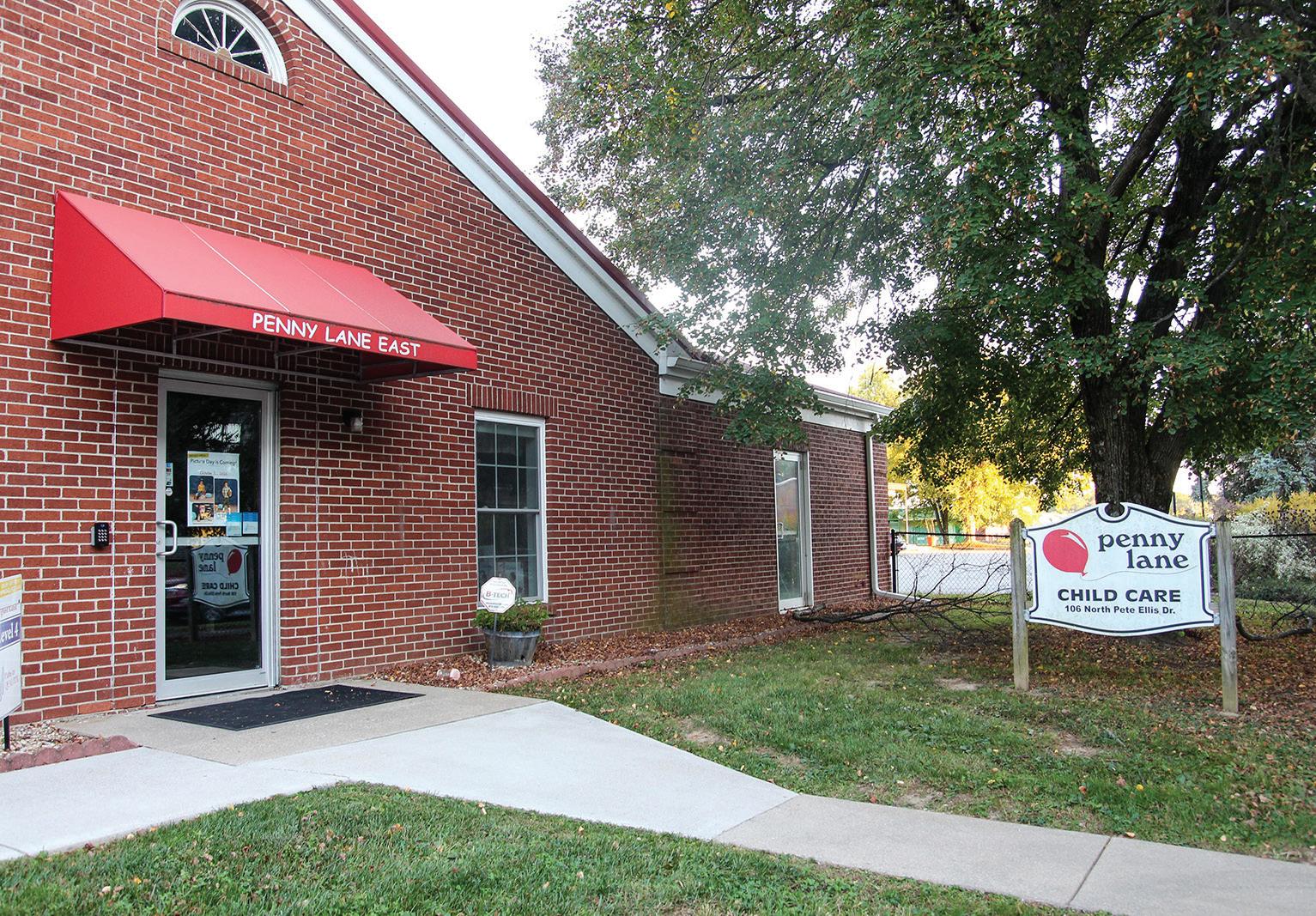
families meet certain income standards, according to an OECOSL press release from December 2024. On My Way Pre-K was partially funded by CCDF funds before 2025.
Hanan Osman, executive director of the Indiana Association for the Education of Young Children, said the waitlist also addresses the state government’s lack of CCDF funds after draining federal emergency relief grants distributed during the pandemic.
When the state government had access to those funds, it raised childcare providers’ reimbursement rates too high to be sustainable and expanded voucher programs, Hanan said. After the funds ran out at the end of 2024, the state could no longer pay for as many children’s childcare.
Indiana Gov. Mike Braun requested a large part of the 2025 state budget be allocated to funding childcare, but the Indiana General Assembly approved only half of what he requested, Hanan said.
The state’s cuts to childcare provider reimbursement also aim to address CCDF’s $225 million funding gap through 2026, according to a press release. The rate changes were based on operating costs data from a survey of 25% of Indiana’s licensed childcare providers.
As of Oct. 5, childcare providers for children 0-3 years old will see a 10% decrease in reimbursement. Those serving preschoolers, 3-5 years old, will see a 15% decrease in reimbursement and for those serving school-age children, a 35% decrease. However, cuts vary by location and can be higher.
Jill’s House has four classrooms and serves infants, toddlers and preschoolers. Its tuition ranges from $265 to $370 per week, and its capacity is about 48 children. Of the around 30 children enrolled as of Sept.
19, 10 rely on childcare
vouchers. Since the voucher rates dropped, families now must pay the difference between the voucher funds and the center’s tuition cost.
“Which for some families means that they’re putting that additional charge on a credit card, which is sad, it’s unfortunate,” King said. “I definitely see it impacting families.”
A survey from Early Learning Indiana revealed 11% of early childcare providers in Indiana predict they might close within the next year because of the lack of public subsidies available.
“I call it the CCDF crisis because it created a crisis to families, to children and now to providers and now is going to create a crisis for the state of Indiana,” Hanan said.
She added that children’s safety is at risk because of the possibility that families will put their children’s care into unqualified hands to avoid high costs.
Kelly Sipes is the executive director of Penny Lane Childcare Centers, which has two branches in Bloomington and serves children from 6 weeks to 10 years old. She estimated that onefourth of enrolled children used vouchers before August. At the end of the 202425 academic year, about 25 children on vouchers across both centers graduated from Penny Lane. These spots are not all filled since none of this year’s incoming children were able to obtain vouchers.
Sipes said she’s seen the funding change coming for six months.
“I knew it wouldn’t last,” Sipes said. “I’ve been doing this for 34 years and until COVID, we never got that much money for a child.”
Sipes said she doesn’t expect the lowered reimbursement rates to affect Penny Lane this year as much as the waitlist has because there are only about eight or nine children at the
centers with vouchers and no incoming families are paying with vouchers.
CCDF vouchers previously paid childcare providers market price for each child on vouchers. Penny Lane charges below market rate, so after covering their tuition cost, the market price voucher reimbursement left them with some extra money.
For example, before the voucher rate reduction, the state paid licensed centers with a level 4 Indiana Paths to QUALITY rating, including Penny Lane, $478 for an infant per week, while Penny Lane charged $245.
Sipes said centers that charge market price will have it tougher, as they will no longer have their full price covered. Sipes predicts the reduced reimbursement rates will still cover most, if not all, of Penny Lane’s price. Without as much funding from the state, Penny Lane has to rethink its budget and consider fundraising.
Sipes said she may have to completely rule out overtime unless necessary, not give teachers raises this year and increase the center’s rates. In the past, the center had a substitute hired in case teachers missed a day, which may no longer be sustainable. Penny Lane might also have to cut down on supplying materials like diapers and wipes to enrolled children.
As an MCCSC partner provider, Penny Lane benefits from MCCSC’s 2023 referendum, which offers discounted or free childcare access to families in 3-yearold preschool programs and 4-year-old pre-kindergarten programs. Sipes said the referendum greatly helps the center.
Both Sipes and King anticipate hardship to result from these recent changes.
“I can’t say that we’re not going to struggle, because we will,” Sipes said. “It’s just all about changing things up.”
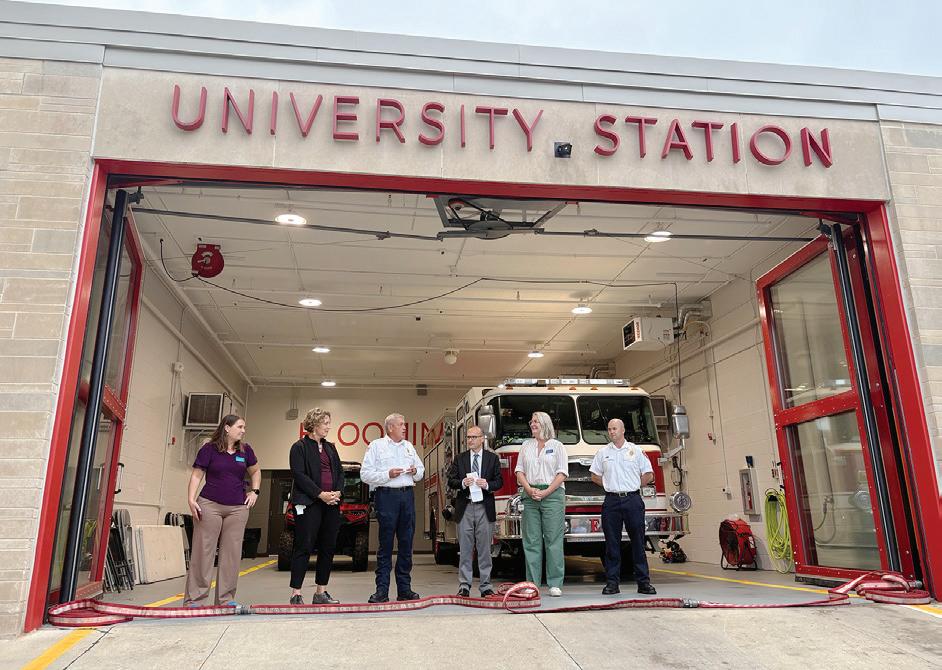
By Will Tallackson wdtallac@iu.edu
The City of Bloomington officially reopened Fire Station 3, located on Indiana University’s campus on North Woodlawn Avenue, after extensive renovations.
The city invested $4 million in the station and began modernizing it in December 2024 for the first time since it was built in 1963. The rededication ceremony, hosted on Oct. 6 to mark the reopening, featured opening remarks from Bloomington Fire Chief Roger Kerr, IU Bloomington Chancellor David Reingold, and other city officials. Reingold thanked the department for its ongoing partnership with the campus and was followed by Bloomington City Council President Hopi Stosberg, who said she appreciated the quality of the upgrades.
Bloomington Mayor Kerry Thomson concluded the ceremony by sharing a story about bringing baked goods to the department on Christmas morning last year while the station was under construction and witnessing the firefighters’ dedication.
“When I was in here in the dead of winter and you all were living in a room with no walls, I thought ‘this is this is unbelievable, what our firefighters do for the community,’” Thomson said. “I’m glad to welcome you home.”
After the speeches, attendees joined firefighters for a brief tour of the renovated facility, which showcased improvements designed to enhance safety, efficiency and comfort.
Before the renovation, the station had remained largely unchanged since it was built in1963. Firefighter Colton Spires said the improvements made a noticeable difference for those who work there.
“I personally got to see the old station for about the first two years I was here, and it was really awesome to see, but the new station, it kind of has a different feel to it,” Spires said. “It’s not
necessarily the same place, and it’s just kind of lifted the morale around here, especially at this station on this crew.”
The upgrades included six new bunk rooms, updated kitchens, separate officer quarters and a new airlock to prevent exhaust fumes from the fire truck from entering living spaces. The renovations also added new Wi-Fi and computer dispatch systems, making it easier to receive calls. Kerr said the renovation brought the station up to modern standards, providing firefighters with better amenities.
“They’re out trying to protect everybody’s lives, so if we can help them in any way, which makes their livings arrangement more comfortable and more up to date, we’re happy to do that,” Kerr said. “And it’s exactly what they got, rather than, you know living in something built in 1963, they’re now living in something that’s brand new.”
Firefighter Manny Cheam said the crew has adjusted well to the new facilities and appreciates the improved design and space.
“I think it’s really good for us,” Cheam said. “There’s a lot more space. The kitchen’s really nice, our bedrooms are a lot better. Our fitness room and our equipment is great and it’s beyond what we had before.”
The renovation was part of the broader public safety bond approved by the Bloomington City Council in 2022, which allocated $34 million for safety projects across the city. The cost of renovating Station 3 was about $4 million, Kerr said.
The same bond also funded the ongoing construction of a new logistics center at 3230 S. Walnut St., which will include additional equipment storage, training divisions and operational centers for the firefighters.
The facility is expected to be completed by August 2026, Kerr said, and will serve as a temporary station if needed.
IUSG eliminated funding for the lease gap scholarship and student organizational support
By Safin Khatri safkhat@iu.edu
IU Student Government cut $56,000 from its 2025 fiscal year budget, decreasing spending by over 16% from $311,650 to $259,200.
A bill passed Oct. 6 rescinded $20,000 from student organization support and $10,000 from the lease gap scholarship fund, eliminating those expenditures. The lease gap scholarship fund was to provide financial assistance to students in between leases who may have faced homelessness.
The bill also rescinded $5,000 for the stop-gap lease initiative from $10,000, which would provide accommodation for students needing housing in between leases, $4,000 in discretionary funds for the IUSG Department of Diversity, Equity, Inclusion and Accessibility, $4,000 from discretionary funds for its Department of Academic
Affairs and $4,000 from discretionary funds for the Department of Sexual Violence Prevention.
However, the bill allocates $500 in new funding for the Makerspace inventory. Makerspace is located in the ClubHub in the Indiana Memorial Union and has 3D printers, sewing machines and more. The budget also allocates a $1,500 increase for the operating expenses of the IUSG Office of the First-Year Internship Program, which provides opportunities for first year students to participate in IUSG. Luke Carman, congressional representative and clerk, said he voted in favor of the bill because it evens the funding allocated to each executive department, but he still supports the stop-gap lease program.
“The lease gap housing rescission is a conversation that needs to be tabled at the moment while we all talk about it and further our
understanding of how that could work in terms of funding and contracts,” Carman said.
Student Body President Zachary Goldberg said when he learned of the need to reduce the budget, the first agreed-upon cut was student organization support. Traditionally, IUSG does not appropriate funding to student organizations. It only did so last year because the IU Funding Board overdrafted its account, Goldberg said.
Last semester, the previous FUSE administration negotiated a rate with the Biddle Hotel in the IMU for the lease-gap program, but the agreement failed to pass the congressional committee on oversight and finance by an April 26 deadline. IUSG committed to permanently funding the lease-gap initiative when Congress passed the LeaseGap Program Funding Act in March 2025. IUSG then
pivoted toward the scholarship program.
Goldberg said the stopgap lease scholarship program was rescinded because of the inability for IUSG to distribute those funds equitably to students. He said the university only allows scholarships to be distributed to currently enrolled students, and students not enrolled in summer classes would be ineligible to apply. He said this past summer, IUSG pivoted funds to the lease gap scholarship program in an attempt to distribute those funds, but it did not work out.
“Also, the program is one that takes place in the summer of 2026,” Goldberg said. “By that time, there will be a new budget, so for it to be in this year’s budget technically isn’t necessary.”
However, the stop-gap lease initiative will retain a $5,000 budget to show IUSG’s commitment to the program.
Student Body Vice President Ava Smith said she is still working on the stop-gap lease program and is exploring new options after negotiations with the Biddle Hotel in the Indiana Memorial Union fell through.
“We decided to pivot with the Graduate (Hotel), and we’ve been in constant communication with them to really try to make this program happen for students because it is something that is important and is something that we want to do if we are allowed to,” she said.
Goldberg said departments that faced cuts can still use discretionary funds.
“As for department cuts, we wanted to make sure the departments still gained year over year,” he said. “So, the departments that we cut are still up from last year significantly.”
IUSG overprojected revenue from the Committee for Fee Review, which al-
locates student mandatory fees to organizations like IUSG, Goldberg said. He said IUSG met with members of the committee to discuss potential revenue in the summer, which is why IUSG projected a higher budget.
Treasurer Aman Gandhi said the budget consists of rollover funds from last year’s budget in addition to CFR revenue.
“How we came up with the total budget was the CFR revenue of $193,000, so that’s how much revenue we got for this year,” he said. “And then we added the rollover, so the $53,000 they didn’t spend (last year) and the interest fund with around $6,000.” The IUSG Congress’ new term commenced Oct. 6 with the inauguration of new representatives. The 2025 fiscal year budget runs through June 30, 2025, and the 2026 fiscal year budget will be adopted in the spring.
Ashley Gilmer (she/her)
is an organizational and business psychology major in the College of Arts and Sciences and has a human resources management minor in the O’Neill School of Public and Environmental Affairs.
In early September, I had the honor of addressing hundreds of members of the incoming class of 2029 at the College of Arts and Sciences’ Induction Ceremony, a special way to welcome new college students to the Bloomington campus, with an added dash of “Pomp and Circumstance.” Looking out at a sea of bright faces, I was reminded how quickly four years can pass and how these first months at IU can set the tone for all that follows.
I’m a senior studying organizational and business psychology in the College, with a minor in human resources management in the O’Neill School of Public and Environmental Affairs. Looking back, I realize my own journey has been shaped less by a straight line and more by unexpected turns, opportunities and connections.
I’ve learned how to thrive at IU, and by sharing my experiences, I hope others can use them to chart their own paths to fulfillment and success.
Explore opportunities and find what fits
Since my freshman year, I’ve learned a few lessons.
First, it’s about the journey,
not just the destination. Yes, graduating matters, but how you spend your time here, who you meet and how you grow are just as important. When I first arrived at IU, I thought I would study clinical psychology and focus on research about the brain. Through the College’s ASURE (Arts and Sciences Undergraduate Research Experience) program, I joined Professor Benjamin Ramsden’s lab as a freshman, where I learned to use electroencephalogram technology to measure brain activity. I performed scans, interpreted wave patterns and gained valuable hands-on experience.
It was exciting work but I realized research wasn’t the career path for me. Learning this early helped me pivot toward something new — and that’s completely normal. College is as much about discovering what doesn’t fit as about finding what does.
For those of you who may face the same uncertainty, IU offers the College’s Q295 Life Design course. It gives students practical tools to explore majors and careers and approach decisions with curiosity rather than fear. It’s designed for students from every major because, at some point, everyone feels unsure about their academic journey, and it can help you determine your next steps with confidence and intention.

For me, one of those steps was a study abroad program through O’Neill. I spent two weeks in Germany and one week in Italy, funded in part by a scholarship, while earning credit toward my human resources minor. It was a once-in-a-lifetime
experience that immersed me in new cultures, taught me about economic development in an international context and gave me friendships and stories I’ll carry forever.
Importantly, that experience showed me the value of
stepping out of my comfort zone. Once I was back on campus, I applied that same mindset to my academic journey. As a liberal arts and sciences major interested in business, I took classes at the Kelley School of Business and built connections there by joining organizations such as a professional business fraternity and the Hoosier Consulting Network — all while staying rooted in the College of Arts and Sciences.
Your academic journey may not be linear — embrace it
Another key lesson I learned was college, like life, doesn’t always follow a straight path. Plans change, challenges appear and sometimes things don’t work out as expected. But that uncertainty has a beauty of its own, because it pushes us to adapt, welcome change and flourish in ways we might never have imagined.
For example, pivoting from clinical to organizational psychology gave me the best of both worlds that I was seeking: the depth and flexibility of a major at the intersection of the natural sciences, the social sciences and the humanities, with the applied experience of a business curriculum.
Eventually, these experiences prepared me for an internship at Eli Lilly and Company, where I worked in human resources. I drew on the skills I had developed, such
as cross-cultural awareness from study abroad, business literacy from Kelley, research and critical thinking from the College, and I applied them to solve real-world challenges for a global company. That internship affirmed for me how a liberal arts and sciences education equips you with skills that are both universal and indispensable throughout your life and career.
Connect and have fun outside the classroom
My journey wasn’t only about academics or career preparation. Some of my most meaningful experiences came from simply saying “yes” to opportunities outside the classroom. I joined an intramural volleyball team — without having ever played before — and found friends, laughter and balance.
It reminded me that growth doesn’t just happen in labs or libraries; it happens on the court, in clubs, in community and in those unexpected moments where you take a risk just to try something new.
As you begin your journey at IU, remember that these four years will fly by faster than you think. So, be intentional with your time, enjoy every moment and find what fuels your energy and passions. The memories and connections you create here will stay with you for a lifetime.
Theo Hawkins (they/them) is a senior studying interactive and digital media with a minor in American studies. Their mom cannot remember if she took acetaminophen during pregnancy.
On Sept. 22, President Donald Trump announced his administration’s official recommendation that people refrain from taking acetaminophen during pregnancy, claiming a link between acetaminophen use during pregnancy and autism based on a meta-analysis published in August. This recommendation was swiftly refuted by the American Academy of Pediatrics, the American College of Obstetricians and Gynecologists, the Society for Maternal-Fetal Medicine, the American Psychiatric Association and the Coalition of Autism Scientists, among many other experts and the broader autistic community.
The link presented between Tylenol and autism is shaky at best. Autism is a very complex neurodevelopmental condition encompassing a broad spectrum of experiences, and scientific consensus is that the causes of autism are just as complex, but it mostly boils down to genetics. Health and Human Services Secretary Robert F. Kennedy Jr. has refused for decades to accept scientific realities that are, at this point, uncontroversial within the medical field and sometimes extremely obvious — and he certainly was never going to be able to do in a matter
Advait Save (he/him) is a junior studying economics and sociology.
As many do after a long day of work, I doom scroll on TikTok. Among cute cat videos and heavy lyrical analysis squeezed into a twominute video, I frequently encounter videos that, to say the least, are a little unfavorable toward South Asians. In my experience, this unfavorability presents itself in the form of videos that depict South Asian people, especially Indians, as dirty or poorly groomed.
The increased prevalence of such content specifically targeting South Asians could be attributed to a multitude of factors. Stop Asian Americans and Pacific Islanders Hate talks about how the rise of anti-Asian slurs, especially those directed toward South Asians, has increased over the past few months. This increase
of months what has taken researchers decades in the study of autism.
Kennedy has repeatedly sounded the alarm over rising rates of autism. Yes, autism diagnoses have indeed risen over the past couple decades, but this is mostly because of broadened criteria for autism diagnosis and more general awareness. More people are seeking a diagnosis, and more people fit within the expanded understanding of the autism spectrum. Importantly, cases of “profound autism”— people with the most visible symptoms and highest support needs — have not risen significantly. Autism diagnoses are increasing among people with what would be considered “milder” forms of autism. I am an example of this phenomenon: I wasn’t diagnosed until I was 18 because no one in my life knew what to look for until then. Again, this is the most straightforward and obvious answer, and yet one that Kennedy refuses to accept. This isn’t the first time Kennedy and the Trump administration have peddled health misinformation the public. Kennedy has said, for example, that the measles, mumps and rubella vaccine is ineffective and dangerous; but, according to the Infectious Diseases Society of America, this vaccine is about 97% effective and prevented about 20 million measles deaths between 2000
and 2016. This isn’t even the first time Kennedy has spread misinformation about autism. Kennedy has famously spent decades claiming that vaccines may cause autism, a theory that was based on a retracted 1998 study led by Andrew Wakefield and has been thoroughly debunked. Kennedy’s pick to head up autism research, David Geier, has already produced multiple discredited studies claiming a link between vaccines and autism and was disciplined in 2011 in Maryland for practicing medicine without a license.
Kennedy’s disregard for actual science reveals the cynicism behind his statements. He does not care about autistic people or our well-being. His rhetoric completely misses the point. He doesn’t simply have the wrong answers; he is asking the wrong questions altogether.
Autism is not something that necessarily has or needs a “cure.” It’s a natural variation in the way human brains work, and it’s older than acetaminophen or vaccines or even autism research itself. I will admit that there are days when I wish that I were not autistic, when I feel particularly lonely or the texture of my clothes makes me want to crawl out of my skin, and I know that there are autistic people with more pronounced symptoms for whom things are much hard-
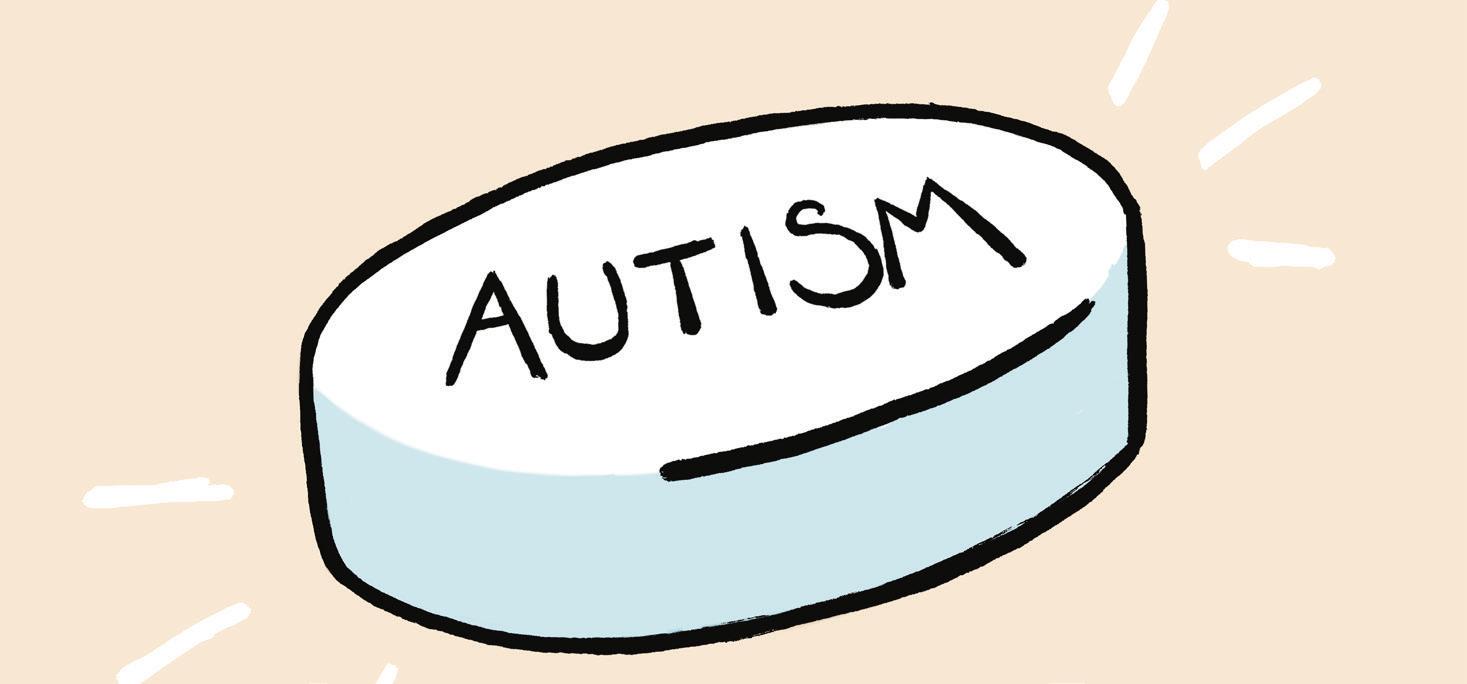
er. But at the end of the day, it’s not a disease that can or should be eradicated like chickenpox. Being autistic is just a part of who we are. I am not a disease. We are not an epidemic. And regardless of what Kennedy seems to think, whether we can pay taxes, write poetry or throw a baseball should not be a measure of our value as people. Autistic people are still human beings deserving of care. What the HHS should be doing, instead of wasting time and resources chasing bunk-science leads on a “cure,” putting out stigmatizing statements and casting aspersions on safe and effective modern medicine, is finding ways to make life better for autistic people and the families of autistic people. What we need is support. What we need is access to quality healthcare and secure housing. We need programs that will support kids whose educational
ADVAIT WRITES
needs are not being met.
We should shift our focus toward building a society that accommodates the natural variations in the human experience rather than perpetuating systems that punish those who cannot conform to certain expectations of productivity and socialization.
That’s not to say that we shouldn’t also research autism. But autism research, like any health research, should be evidence-based and thorough. Rather than investing in research on environmental causes for which we already know there is no evidence, we should invest in studies that go where the science is leading us. That’s mostly going to be genetics.
Instead, the Trump administration is doing what it has always done: pulling stunts for political points and media attention while absolving itself of responsibility for any of the real, hard work, and doing so with complete
It’s high time to address anti-South Asian hate
is particularly prevalent in online spaces associated with targeted violence like 4chan. Hate toward marginalized communities is as old as time; however, this recent increase could be attributed to a few socio-political events in America.
The spikes in anti-South Asian hate are directly related to things like Kamala Harris’ presidential run or Usha Vance’s rise to the spotlight during Vice President JD Vance’s election bid. A more recent increase is associated with the rise of the Democratic mayoral candidate for New York City, Zohran Mamdani. According to Stop AAPI Hate, the ongoing debates about the H-1B visas and the recent skirmish between India and Pakistan have brought South Asians into the spotlight.
Alas, this spotlight also comes with a reignition of the prejudices against South Asians in the public sphere.
Social media presents itself as a platform for expressing this. Addressing this prejudice is key to challenging this very pressing issue of hate against a marginalized group like South Asians.
I won’t delve into the origins of prejudice. I will, however, emphasize framing social media as a public sphere and how establishing baseline ethics for engaging with this public space can help us tackle the issue of hate driven by prejudice.
Here’s a hypothetical scenario: I, as a South Asian, feel unwelcome because of flags or banners hoisted in an area with slurs or hateful language directed toward my ethnicity. I am naturally bound to develop an unsavory notion about that area, irrespective of the views of the people living there. There is a good chance that not everybody living there has the same attitude toward South Asians, but for
me, the optics of the visit itself are enough to make me not feel like going there again. I do not hold myself at fault for developing this notion precisely because the community of that area has created a permission structure that allows this open display of prejudiced hate. This is very much analogous to the environment on social media. Due to its limited ability to regulate speech and simultaneously uphold the principle of freedom, established platforms like Instagram or TikTok fall prey to creating a permissible environment for hate online. They do not endorse hate content, nor do all of the users on these platforms. However, the existence of such content is evidence of a lack of ethics in communication on online platforms. The issue of hate online is not one of content but rather of method, or a lack thereof. In a discussion on regulating
free speech in my political philosophy class, a classmate of mine proposed the idea of regulating the method of speech rather than its content. I cannot advocate for the regulation of speech from an authoritative position. However, the idea of establishing a basic ethic or civility of communication seems attractive to me, especially in the case of addressing hate online. A simple rule that all of us can follow is to consider how expressing something hateful toward another human being might affect them. I am of the strong belief that most hate isn’t malicious, and everyone who expresses hate can be convinced to turn away from it. It must start with us students, probably the most chronically online generation who will develop into future productive members of society.
Our membership in a
ILLUSTRATION BY THEO HAWKINS
and reckless disregard for the consequences for everyone else.
The good news is there are plenty of people out there who do have the best interests of the public at heart. While you should regard health statements from Kennedy and the Trump administration with extreme caution, you can for the most part trust actual scientists. When you see a health claim, think about what the message really is, and doublecheck the facts before sharing that information. Listen to the experts. Listen to autistic people and treat us like human beings. Combating misinformation in your own circles and maintaining empathy for the people around you seem like small things, but all of us doing these small, good things will be critically important for public health and well-being. sohawkin@iu.edu
public space itself should push us to develop a safe environment for everyone to exist in. This includes calling out hate when we see it expressed and responding graciously to people who express hate. Offering grace and love can help people recognize their own humanity and inspire them to recognize the humanity of others. This recognition can come by educating ourselves and people around us about the harms of hate, and just making an effort to support the victims of hate. The key to live by an ethic is to use our platforms with purpose; we must be active participants in the public discourse as silence is complicity. Be it online or in person, our method of engagement with others must mirror a basic ethic of grace and humanity that everyone deserves. ausave@iu.edu
Community members in the Cottage Grove neighborhood are mobilizing to prevent possible demolition
By Grace Fridy gfridy@iu.edu
Multiple property owners in the Cottage Grove neighborhood have requested demolition permits in recent months, sparking efforts from residents to designate the area located northwest of campus as a conservation district.
Becoming a conservation district limits both demolition and new construction within a neighborhood, requiring approval from the Bloomington Historical Preservation Commission.
“It’s not like a homeowners association where you might have a set of rules about, you know, I don’t know, sort of daily issues,” said John Butler, an organizer of the districting efforts. “It’s more of a set of guidelines for properties. And so, unless you’re planning on tearing your house down, it won’t have a huge effect on you.”
Property owners, residents and non-residents met Sept. 29 for the second of three public information meetings required by the city’s Housing and Neighborhood Development Department. The meeting, held at the downtown branch of the Monroe County Public Library, focused on issues such as outlining boundaries for the district and deciding on a name.
While the neighborhood is referred to as Cottage Grove on the City of Bloomington website and as the Cottage Grove Historic District in city brochures, it is not yet designated as a historic district. Multiple residents at the meeting said the neighborhood has never had a specific name.
The meeting was led by Butler and his wife, Amy Butler, both of whom are
residents and property owners in the area. They estimate around 89% of the neighborhood residents are renters, including many students.
One IU student, senior Tyler Kern, has lived in the area for the past two years. He lives on East 12th Street with four friends who were looking for “the classic college feel of an old house” when deciding where to live. Kern is in favor of efforts to designate the area as a conservation district.
“I feel like the main points of it are preserving the culture and preserving the value of IU and as well keeping the housing affordable for students because that’s what this community is built on,” Kern said.
The Butlers first began looking for a way to prevent possible demolition in their neighborhood after John Butler’s childhood home located on East 12th Street faced demolition this summer. They are concerned that demolition could lead to the development of larger complexes that would take away from the character of the neighborhood.
“We’re just afraid that other things will go, because what they’ll do is they’ll put in the largest thing they can there, and then other neighbors won’t like it, and maybe then they’ll consider selling out, and that’s what we’re afraid of,” Amy Butler said.
In a letter to the HPC, Judith Barnes, a former owner of the home, expressed concern over the structure’s possible demolition.
“I am devastated to think that such a lovely, well built, 100 year old house will be reduced to rubble,” Barnes said in the letter.
Additionally, the HPC considered the demolition delays of two houses within the proposed conserva-
tion district on East 11th and North Grant streets this summer and recommended the release of both demolition permits, which would allow the demolitions to move forward, although the structures currently remain standing.
While the Butlers believe the owner of the home on East 12th Street is open to selling instead of demolition, residents still have concerns that more houses in the area could be demolished, possibly to create larger developments.
“And, you know, once these 100-year-old houses are gone, they’re gone,” Amy Butler said. “They don’t come back. And the trees are all torn down. And then you’ve got these big buildings that do not fit the fabric of the neighborhood, that totally change the look and the feel.”
After the Sept. 29 meeting, a minimum of one more public information meeting is required before the HPC will consider a proposal for conservation district designation. The Butlers plan to hold another meeting Oct. 16.
“As they start coming together, they will define — they’ll settle on the boundary issue,” Karen Duffy, a non-voting member of the HPC, said. “What is this area exactly? Where are the edges of it?”
Going forward, the group will have to compile an application to submit to the HPC for conservation district designation after the required meetings. The HPC will then have a public hearing and choose whether to recommend the designation to the Bloomington City Council. The City Council, which has final say, will then vote on the designation. In recent years, other

neighborhoods in Bloomington have also worked toward conservation districts designations. The HPC recommended in August 2024 that the Bloomington City Council designate the Green Acres neighborhood as a conservation district.
After significant community backlash due to the possibility of increased cost of living, the Green Acres Conservation District Development Committee withdrew its petition to the City Council on Sept. 30, 2024. The proposed district would have included 447 homes, including five that had been slated for demolition in August of that year.
James Ford has resided in Cottage Grove for 40 years and is working with the Butlers to have Cottage Grove designated as a conserva-
tion district.
“And maybe there won’t be so much support as a whole for Green Acres, but ours is more confined, it’s more historic, it’s more preserved, more valuable to that,” Ford said. The current draft of the conservation district map, which was first reported on by the B Square Bulletin, includes about 100 homes, less than the proposed Green Acres Conservation District.
If successful, the neighborhood will be a conservation district for three years, after which it will be elevated to the level of full historic district unless a majority of homeowners object. In that case, it will remain a conservation district.
Currently, Bloomington has 13 historic districts,
with
being the most recent additions.
In August, five houses along Jefferson Street faced demolition. These five properties, all small houses built in the 1940s and early 1950s, lie within the Green Acres neighborhood, just east of IU’s campus.
“Well from my point of view, it’s because these buildings are not just nice to look at, but they are evidence, physical evidence of the community’s past,” Duffy said on the importance of preservation.
The next public information meeting is scheduled for 7:30 p.m. Oct. 16 in meeting room 1B of the downtown branch of the Monroe County Public Library.
By Dalton James and Benjamin LeGrand jamesdm@iu.edu | benlegra@iu.edu
A fire at First Christian Church ignited the church's roof just after 3 p.m. Oct. 1, causing the building’s evacuation and smoke to billow over downtown Bloomington. Max Litwin, the deputy fire chief at the Bloomington Fire Department, said nobody was injured in the fire, as smoke and water damage was confined to the front area of the church. The fire is fully extinguished. Roofing materials caused the smoke, Litwin said, but the cause of the fire and ignition is still under investigation.
At least seven fire trucks were at the scene, including two using ladders. At least one ambulance was present.
The Bloomington Fire Department received the call just after 3 p.m.
With some of East Kirkwood Avenue restricted to pedestrians, the yellow bol-
“Real thankful that no one got hurt. We’re just praying this doesn’t affect our church, the ministry and the good work that we’re doing for folks.”
First
Caleb Hoagland,
Christian Church interim director of outreach
lards were removed to allow fire trucks to better access the fire. Two trucks were still able to water the fire from Washington Street, Litwin said. Caleb Hoagland, the church’s interim director of outreach, said an employee yelled “fire” and pulled the fire alarm. According to Litwin, the fire department received a call at approximately
3:06 p.m. The fire department, which is located less than a half mile away from the church, was on scene within five minutes.
“Fire department did a great job,” Hoagland said. “It was out very quickly, so we hope the damage was mitigated.”
The 199-year-old church has undergone construction, Hoagland said, as there were “major structural things” that needed updated. He said they recently finished a capital campaign that had “great community involvement” and “great congregation support.”
“Real thankful for the fire department,” Hoagland said. “Real thankful that no one got hurt. We’re just praying this doesn’t affect our church, the ministry and the good work that we’re doing for folks.”

By Ella Curlin elcurlin@iu.edu
Award-winning conservationist Mwezi “Badru” Mugerwa spoke to about 50 people at Franklin Hall on Oct. 1 about his work to protect the vulnerable African golden cat.
Mugerwa’s presentation was arranged by the Indianapolis Zoo. In March, Mugerwa was announced as the 2025 winner of the Indianapolis Prize’s Emerging Conservationist Award, which is awarded to impactful conservationists under 40 years old. Indianapolis Zoo President and CEO Robert Shumaker said the Emerging Conservationist Award was created two years ago to boost young conservationists at critical moments in their careers.
“We wanted to catch them at that crossroads, give them the momentum, give them the lift, give them the support, give them the visibility,” Shumaker said.
Mugerwa founded the grassroots conservation group Embaka, which organizes community-based conservation projects and
hosts the African Golden Cat Conservation Alliance, a network of conservation efforts across multiple countries.
These groups work to protect the African golden cat, an elusive spotted cat that lives in forests in westcentral Africa and along the continent's west coast.
IU Environmental Resilience Institute Managing Director Sarah Mincey and IU President Pamela Whitten introduced Mugerwa. Whitten called Mugerwa a “visionary.”
In an hour-long presentation, Mugerwa spoke about how his conservation projects involve communities in the protection of the African golden cat.
African golden cats have lost nearly half their habitat to human activity and are vulnerable to extinction from habitat loss, shrinking food resources and hunting.
Mugerwa spoke about how he worked with communities around Uganda’s Bwindi Impenetrable National Park to decrease the threat of bushmeat hunting, which targets wild animals for food.
Mugerwa said while many Ugandan hunters
avoid hunting carnivores due to custom, African golden cats are often accidentally killed by snare traps.
Mugerwa’s organization created programs that provided livestock to replace food from bushmeat. People who received livestock agreed to pass the offspring to their neighbors, sustaining the practice.
Mugerwa also spoke about his camera traps, which gather information about the African golden cat’s habits and population density.
Embaka conservationists collaborated with big cat conservation group Panthera to use artificial intelligence algorithms that identify wild cats caught on camera traps, improving the speed and accuracy of research efforts.
During a Q&A session after the presentation, Mugerwa said he worked with community members, including former poachers, to understand where to place camera traps.
“I did a bad job initially camera trapping the species, because I didn't really place the cameras to get, you know, to get a decent amount of data on the cam-
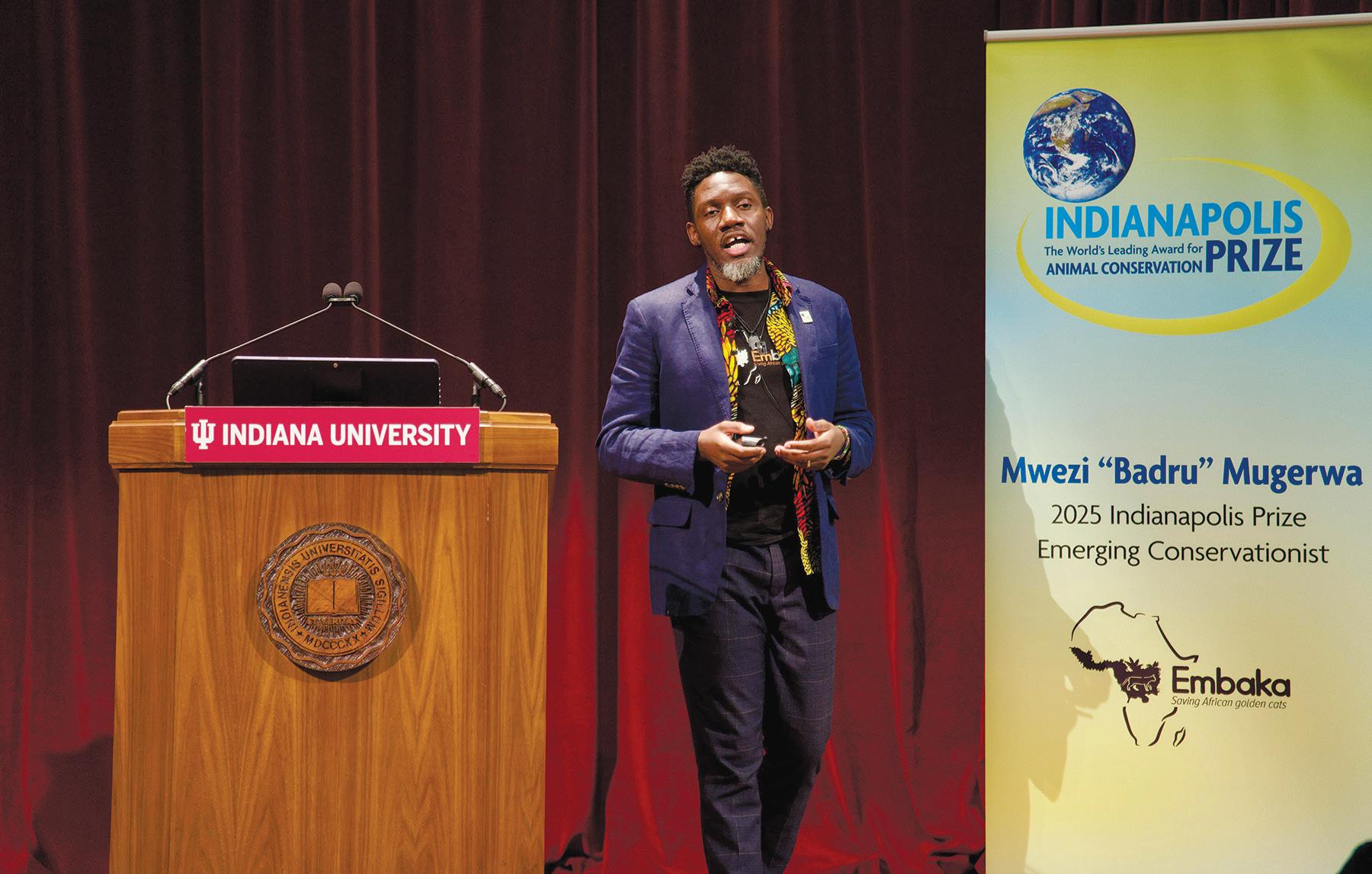
era traps,” Mugerwa said. “I had to go back to the hunters, and they showed me where they thought, I'll be able to collect, you know, good quality data."
Mugerwa said efforts to conserve wildlife should always take local communities into account.
“I learned very quickly, you cannot separate animals, wildlife and people, because if you think about it, the threats we work to address, there are threats that are brought to the wildlife by people,”
said. Mugerwa also founded the African Golden Cat Conservation Alliance and serves as the president of Africa Region of the Society for Conservation
He said people in Indiana and across the world should try to spread awareness about conservation. “Conservation is a global cause,” Mugerwa said. “Whatever we're doing in Uganda or in these 18 other countries, it also benefits the rest of the world. So people in Indiana definitely need to be part of this conversation.”
Jacob Fry (he/him)
is a junior studying political science.
“Make America Great Again” — four words that have completely shifted the modern political climate. What began as a simple campaign slogan for Donald Trump has become something far bigger than anyone could’ve imagined. It’s grown to be an identity, a rally cry and a tale for the man who seemingly cannot be moved.
The slogan was simple, something that was vague enough to make sense but explicit enough to rally behind.
Donald Trump announced his presidential campaign in June 2015, to which many thought he wasn’t serious about running. It seemed like a marketing stunt. Reporters at the scene noted that it seemed like many of the attendees were paid to be there. The thing was: he was serious.
His messaging was blunt, emotional and divisive. He promised a border wall funded by Mexico, a temporary travel ban on Muslims and a hardline approach to immigration and trade. The political establishment dismissed him, but the voters didn’t. Millions of Americans, especially those from workingclass backgrounds, rural areas and those disillusioned, saw him as their voice and a new type of candidate. The positions that would’ve ended other campaigns instead became fuel for his.
The strategic choices he made amplified his movement. He campaigned in swing states and nominated Mike Pence, the former governor of Indiana with an evangelical appeal, as his running mate. Trump didn’t campaign as a politician; he
Eduardo Merecci Machado (he/him) is a junior studying neuroscience.
campaigned as an outsider who wanted to dismantle the system from the inside. This helped amplify his reach into staunch conservatives and helped move his ideal demographic closer.
Despite scandals that would’ve normally ruined a campaign, such as mocking a disabled reporter, the Access Hollywood tape and countless offensive remarks, his support stood firm. It came to a head when he controversially beat Hillary Clinton in the 2016 election, launching MAGA from a slogan to a worldwide force.
Trump’s first term didn’t dilute the movement; it enhanced it. He rolled back Obama-era policies, reignited tensions abroad while trying to water down others and used impeachment as a rallying cry instead of a scar. Each controversy fed into the story his supporters believed: that he was under attack simply because he didn’t play by the traditional rules. His fans didn’t treat him like a typical president; they treated him like a figurehead. They used hats, shirts, rallies and social media to show their support for him wherever they could. They pledged their allegiance to something beyond the country, but to an individual. Looming threats of illegal immigrants taking their jobs, inevitable inflation and the ire toward traditional families helped Trump stay afloat, as to them, he could fix those things. Even as he faced two impeachments — one for trying to use Ukraine to interfere with the 2020 election, the other for the January 6 Capitol riot — his base held firm. For them, every attack from the media or opponents wasn’t proof of wrongdoing;
it was proof of persecution.
Trump would eventually stumble by losing the 2020 presidential election to Democrat Joe Biden. Yet his loss wasn’t the end of MAGA; instead, it became a defining moment. Rather than conceding to Biden, Trump claimed the election was stolen, a sentiment he echoes from the White House today. Conspiracy spread faster than facts, and his supporters leaned on him more than ever. “Stop the Steal” rallies emerged nationwide, and the phrase became a trending topic on social media. It culminated Jan. 6, 2021, when Trump told his supporters to “take our country back.” What followed wasn’t a sudden attack; it was the manifestation of years of rhetoric and loyalty.
His second impeachment didn’t end the movement; it energized it.
Even after leaving office, Trump remained the nucleus of the movement. His words were used by conservative politicians, media figures and candidates desperate for his base. His endorsement became political gold. Such as in the case of 2022 Pennsylvania gubernatorial nominee Doug Mastriano, a high-risk pick who won the Republican primary due to Trump’s endorsement. Republicans who once denounced him have backtracked to secure a seat at the table, JD Vance being one of them, who now serves as vice president after previously condemning him.
Internationally, politicians modeled themselves after Trump, proving MAGA had crossed borders as a political strategy.
You’d think convictions, scandals and associations would shatter his momen-

tum. Trump was found guilty of 34 felonies in New York. He’s faced public accusations of close ties to Jeffrey Epstein. His past and present are filled with scandal. Yet nothing seems to stick, at least, not to his followers.
That takes us to today, where Trump has been elected for his second nonconsecutive term after defeating former Vice President Kamala Harris. His first nine months have been marked by scandals stemming from his harsh deportation policy, an unqualified cabinet and his approach to international
EDUARDO EXPLAINS
relations. Yet, he’s still standing because of the power he’s amassed from both the government and his followers.
The durability of MAGA is rooted in the ideas of nostalgia for old America, distrust of institutions and unwavering loyalty. Trump didn’t just lead a movement; he built an identity people don’t abandon, even when facts or morality demand it. Its persistence shows that today’s politics focus on identity and loyalty, rather than policy. Even with the cracks, the movement isn’t dying; it’s just shifting. His supporters don’t follow him like a politician. They follow him like a tribe, a team, a belief system. Every indictment is proof he’s fighting for them. Every scandal becomes a loyalty test. And that’s why he persists. He’s made moderates into conservatives. He’s
and it goes wherever it takes them and us.
fryjf@iu.edu
AI is unavoidable. Students should know how to use it
By summer 2023, ChatGPT-3.5 had more than 100 million users just three months after release.
College students across the country were excited to finish a week’s worth of homework in two hours, tech experts heralded it as the next big thing since the internet and companies scrambled to adopt AI, chasing billions of dollars in venture capital.
Two years later, excitement and uncertainty now coexist. Anthropic, a leading startup behind the chatbot Claude, just settled for $1.5 billion over copyright infringement during the training of its model — a reminder of AI’s legal and ethical issues.
Artificial intelligence is no longer optional for college students — it’s a skill as fundamental as writing or communicating effectively. Learning to use AI responsibly and in humancentered ways is essential for students to succeed academically and thrive in a workforce increasingly
shaped by technology. Indiana University is embracing OpenAI’s ChatGPT by giving 120,000 students, faculty, and staff free access to ChatGPT Edu, a campus-specific version of the chatbot designed for education, along with a GenAI course that teaches responsible use of AI. The rollout, starting in January 2026, will be one of the largest of its kind. Yet, IU has not addressed the risk that our diplomas might become outdated by the time we graduate. As AI automates tasks once reserved for college graduates, from engineering to journalism, students without AI literacy may find their skills less relevant in an AI-driven workforce.
Companies are pushing a quasi-utopia where agentic AI models replace most college-educated workers, rendering graduates outof-date.
Are we staring at a bleak future?
The answer is nuanced.
IU’s push toward AI will positively affect students’ educational experience by encouraging literacy of emerging technology, pre-
paring them for an increasingly AI-driven workforce.
Corporate AI efforts are multifaceted. Tech giants such as Google have long faced criticism for using AI to collect and monetize user data and for developing algorithms that encourage addictive “doomscrolling”. Yet these same companies, through divisions like DeepMind, are also advancing biomedicine by applying AI to protein and genome prediction, accelerating drug discovery and enabling earlier cancer screening.
AI is changing who gets hired and how work is done. The creator of ChatGPT, Sam Altman, spoke about the rise of new billion-dollar companies built by solo entrepreneurs who master AI tools. One example is Base44, founded by Maor Shlomo, which reached 300,000 users and $3.5 million in revenue within six months before being acquired by Wix for $80 million in 2025.
Two years ago, the conversation centered on AI’s promise for an exciting future. Now, it often turns to workforce replacement
and even cases of AI psychosis — when vulnerable users slip into conspiratorial or delusional thinking through AI conversations.
Though most discussions focus on high-stakes environments, there’s another angle — AI designed to make people more fruitful, rather than to completely replace them.
Classroom AI tools show how technology can support students and tutors alike, enhancing learning rather than replacing human guidance
NotebookLLM allows students to upload course material and study with an AI tutor through quizzes and in-depth explanations.
Another good example is Otter.ai, which records audio and generates accurate transcripts. This can help students stay focused during class and later review the transcripts or feed them into NotebookLLM to strengthen studying.
And for students looking to elevate their college careers, Bloom is especially good. Its AI model vets the best internships based on individual interests, giving users an advantage over
ASK AINSLEY

students who are searching manually.
Scite, an AI research partner, finds the highestquality references in seconds, which saves hours in manual researching for sources and gives students more time to write a higher-quality paper that will yield a higher grade.
These resources combine to form a powerful AI toolset for IU students. They save time and reduce busy work, providing tangible proof that human-centered AI can help people perform at their best.
As AI technology matures, it’s crucial for students to advocate for IU to adopt human-centered AI tools. Many AI companies are still unprofitable, and with a multitude of models available, competition is fierce. They often rely on large contracts, such as IU’s partnership with OpenAI, making this the perfect opportunity for students to push for change and demonstrate that their voices can shape the future of AI.
edmemach@iu.edu
Making mental health work for you when IU resources haven’t
Ainsley Foster (she/her) is a senior studying elementary education and children’s mental health.
Query from reader: “After ADHD and depression diagnoses in my last year of college, I often wondered about IU’s actual disability accommodations. I’ve been placed in an exam room with the same amount of people but spread out; why is this considered an accommodation? It’s still stressful if we have all these people and the time up on the board. Why isn’t there more ADHD awareness in college campuses for students? I’m aware of the medication over usage, but I couldn’t even find a pharmacy that could fill my scripts for weeks in Bloomington. There are good study techniques for those with ADHD, which I was never taught about until actually reaching out. It’s the same often with depres-
sion. I think IU Counseling and Psychological Services does not do a great job at mental health care. It takes weeks to get into just to have some dude to just tell me to take a shower. I wish I could often redo my college years with the knowledge I have about myself now, but I can’t. Why hasn’t IU done more for internal mental health?” This query has been edited slightly to adhere to the IDS’ style. First, I am so sorry to hear that has been your experience with mental health at IU. I can’t imagine how difficult and confusing it must have been up until you finally received a diagnosis in your last year of school. I am sorry that you feel the efforts you made to get help were in vain. You raise many points here, from disability accommodation to medication to therapeutic techniques. I can’t speak for IU or explain why the university has or
has not done certain things, but I can give some advice as for how to proceed when what you try related to your mental health just isn’t working out like you hoped. If that sounds like you, keep reading. The world is a better place with you in it.
After struggling with my own mental health and witnessing the experiences of the children I’ve worked with, I added a Children and Adolescent Mental Health minor to my elementary education degree so that as a teacher, I can be the best possible asset to my future students. Hopefully, this experience makes me an asset to you.
Start by finding someone you trust, and tell them what’s really going on. It could be a friend, family member or roommate. Just talking about what you’re going through with someone can help put things into perspective. Opening up to someone else can also
help you find a new way to look at things or resources you might not have known about before. Even if it feels uncomfortable or vulnerable, letting someone in is the first step toward healing.
In the spirit of opening up to those close to you, I spoke with my roommates, Ethan and Bella, about their own struggles to get medicated for anxiety and depression. Both roommates stressed the importance of talking to someone else about what you’re going through.
“There were things in my life that I thought no one would understand until I talked to my close friends about it,” Ethan said. “And I realized I wasn’t alone.”
“Getting things out puts things into perspective; it’s easy to feel alone when you keep things tucked away,” Bella said.
Regarding professional help, I know you said you’ve
tried before and it didn’t go as expected, but anything worth trying is worth trying again. A professional can help you create a plan and develop strategies for coping. Just because something hasn’t worked yet doesn’t mean it never will.
Another step is establishing healthy, daily routines that support wellbeing. This could include getting enough sleep, eating regularly, exercising, spending time outside or setting aside several minutes each day for relaxation or mindfulness. Consistency in these small habits can make a big difference in stabilizing mood and reducing stress. Building structure into your day helps you feel more in control, which is especially important when everything else feels overwhelming.
“You’re never too far gone to recover,” Bella said.
Healing isn’t linear, and it’s okay if it takes time to
find what works for you. The most important thing is that you don’t give up on yourself or the hope that things can get better because they will. Remember, progress often comes in small steps, not big leaps, and every step forward counts, even on the hard days. Keep advocating for yourself and keep believing that your story is still unfolding. There are people who care deeply about you and want to see you heal, even when it doesn’t feel that way in the moment. You deserve support, peace and joy in your life. Healing takes time, but with persistence and the right help, things truly can and do get better. To submit a question or tell me what’s on your mind, fill out the Google Form, or email me at askainsleyatiu@gmail.com. I’m only an ask away! ainsfost@iu.edu
Although
Sophie Albert soalbert@iu.edu
Taylor Swift released her 12th studio album Oct. 3 after much anticipation from fans. The album, titled “The Life of a Showgirl,” aimed to pull back the curtain on her life as a performer and public figure with extravagant and theatrical theming, and while it sounds refreshing, the lyrics are not nearly to the standard I would expect from Swift.
When the clock struck midnight and I first hit play on the album, I wasn’t sure what to expect. For her past two albums, “The Tortured Poets Department” and “Midnights,” I felt that Swift’s pop music had become boring. Many of the songs sounded similar in production and lacked the liveliness of her most wellreceived pop album, “1989.”
So, I was pleased to finally hear songs that not only sounded different from her past two albums but had a specific “sound” besides generic pop. This is thanks to the fact that she changed producers for this album, working with Max Martin and Shellback, who have produced some of her biggest hits like “Style” and “I Knew You Were Trouble.”
My favorite song on the album is definitely “Opalite.” I love how bright and cheery the song is, and, unlike many songs on the album, I didn’t find any of the lyrics offensive to my ears. My ini-

tial thought when listening to this song was “this could probably single-handedly cure depression,” which is a testament to how optimistic it feels. I also enjoyed “The Fate of Ophelia.” It’s a strong opener for the album with good lyrics and a solid instrumental, putting an interesting twist on the Shakespearean story of Ophelia. The music video for this track, which I got to see in theaters as part of “The Official Release Party of a Showgirl,” is one of my favorite music videos Swift has ever done, bringing the song to life beautifully. Additionally, I liked “Wood,” however, the sexual
innuendoes go hard in this one. It felt more like a Sabrina Carpenter song than a Taylor Swift song, which felt apparent throughout the album. While the play on classic superstitions was intriguing, and I loved the production on the song, the lyrics make it an interesting listen to say the least.
Speaking of lyrics, I must address the elephant in the room. I never thought the day would come that I would say that Taylor Swift’s lyrics were so bad they gave me a headache but, alas, here we are. While it’s not the case with every song, some featured lyrics so cringey that I physically recoiled while
By Lily Saylor saylorl@iu.edu
Thousands of comments flooded IU freshman Lena Apolskis’ TikTok on Sept. 16.
“What in the ‘Pitch Perfect’ is going on?”
“Do they do weddings?”
“Close enough. Welcome back Treblemakers.”
The TikTok video, which has amassed over 31 million views, features members of Another Round, IU’s all-male a cappella group, serenading Apolskis’ friend with R&B singer Jeremih’s hit song, “Birthday Sex.”
Within a week of Apolskis posting her TikTok, Another Round had received over 100 booking inquiries. Currently, the group performs an estimated 10 birthday events per week at dorms, apartments and sorority houses around campus.
“I feel like they definitely deserve the hype because I feel like they did a really good job,” Apolskis said. “It was definitely entertaining and fun. And our friend was definitely really surprised, and she loved it.”
IU sophomore Jamie Davis, junior Chaitan Grewal and senior Bailey Jackson Reese are members of Another Round and said they never expected Apolskis’ video to garner so much attention online.
“I wouldn’t say that that video itself deserved to go viral, but I think some sort of video of ours was bound to go viral at some point,” Davis, the group’s assistant business director, said. “It’s just funny that it was that one.”
With the rise in popularity, Another Round has been booked and busy. While the group performed at dorms and apartments before the viral video, they typically only had one or two each week.
On Sept. 22, Another Round posted a TikTok video promising four free winter show tickets to whoever’s TikTok of them performing gets the most views from Sept. 21 to Dec. 10.
“That’s kind of where we’re trying to filter all this towards is our shows that we have because that’s a big showcase of who we are as a group, not just one-minute songs and clips and stuff like that,” Grewal, Another Round’s music director, said. “Really trying to get people in those seats.” Reese, the social media

manager, said that, in a way, everyone in Another Round is finally living the dream, especially when the members first arrive at the event they were booked for and see the amount of people excited to watch them perform.
“It feels like we made it just by so many people being excited to see us,” Reese said. “That never leaves, really. It’s like two, three times a night we would get that experience and that’s another reason to come back again the next day.”
After Apolskis’ video, an influx of TikTok videos were posted, all documenting Another Round’s performances. A majority of the comments on those videos compared Another Round to the Treblemakers, a fictional collegiate male a cappella group from the 2012 comedy “Pitch Perfect.”
“We strive to do a lot of our songs like them because people recognize those songs the most,” Grewal said. “But we’ll still put our own spins on it and change the lyrics a little bit, so we try and make it our own.”
Embracing the comparison, Another Round will perform a “Pitch Perfect”themed gig at 8:30 p.m. Oct. 24 at Merrill Hall alongside Ladies First, IU’s all-female a cappella group. The two groups will sing songs from “Pitch Perfect” and its 2015 sequel. Tickets to the twohour show cost $8. Following the combined gig, Another Round has a winter show at 8 p.m. Dec. 12 at the Buskirk-Chumley Theater. Ticket information will be available closer to the show date. For more information about upcoming performances, visit their
website.
While singing in an a cappella group is a collegiate hobby for jazz voice major Reese and guitar performance major Grewal, they both plan to pursue music professionally after graduation.
“This is the group where I learned to sing bass and I learned percussion and I learned how to arrange; this group taught me the majority of what I hope to be doing professionally,” Reese said. “Whether that is going on tour with a bunch of other guys or going on tour alone or being stuck in a studio booth, that’s where I want to be in the future, and I owe a large majority to this group.”
Grewal agreed, noting that ideally, he would prefer to perform with a band and said it is always enjoyable to share music with both the audience and the people on stage.
“Half the fun of this group is being able to look over the people across from you and know that they know the music just as well as you, and you can play off their energy and kind of elevate that performance even more,” Reese said.
While finance major Davis’ career plans are not as solidified, he said he will always try to keep music in his life.
“The teamwork aspect of singing in a cappella is very important in all aspects of life and learning how to work with people especially when things get stressful and you don’t know a note or you need help with something, anything like that,” Davis said. “Teamwork is in all aspects of your life, so I’ll take that with me and try and sing as much as I can.”
listening. For example, in the song “Eldest Daughter,” Swift sings: “But I’m not a bad bitch/ And this isn’t savage.” While she sings this ironically, it’s still so cringey that it ruins the entire song. I liked the concept of this track and what she was trying to explore, but hearing her dramatically sing “This isn’t savage” over an acoustic piano will never make me not want to scream into a pillow.
I also didn’t like “Wi$h Li$t” or “Honey.” These songs don’t feel witty or introspective, just cheap. I don’t understand how songs like these are made by
someone considered to be one of the best songwriters of all time.
While I think “Honey” had an interesting concept and could have been an intriguing way to reframe the subject of pet names, the lyrics felt cheesy, and the production was boring. I also don’t understand why Swift needed to use “bitch” to refer to women so much in this album; it felt derogatory for no reason. For example, in this song she sings: “And the bitch was tellin’ me to back off/ ‘Cause her man had looked at me wrong.”
While I understand this person was maybe not pleasant to Swift, it feels aggressively
rude to refer to her like that and easily could have been avoided. “Wi$h Li$t” felt a bit insensitive to me, as it’s just a billionaire talking about other people wanting expensive things when all she wants is a suburban life with kids. While I get the sentiment, I think this topic was addressed much better in her song “The Prophecy” from “The Tortured Poets Department.” These songs are different genres, but the way wanting true love over money is addressed in “The Prophecy” feels raw and poetic, while in “Wi$h Li$t” it just feels obnoxious and cringey.
Overall, I would say “The Life of a Showgirl” is not Taylor Swift’s best moment. While it’s sonically pleasing, there’s a certain emptiness to the album. It lacks the passion, heartbreak or distinctiveness of her past projects. And while all of the songs may get me dancing, I don’t think any of them really make me feel, which is something Swift usually excels at. I’m excited to dance around to these songs in the coming weeks, but there are some songs on this album that I hope I never have to listen to again. More importantly, I hope that Swift takes a step back and realizes there is a line that shouldn’t be crossed when it comes to cringey lyrics, and that she ran over it at full speed with this album.

Photographer Rodney Margison’s new solo exhibition celebrates Down Syndrome Awareness Month
By Lexi Bunting lexbunti@iu.edu
Bloomington photographer and Bloom Magazine managing editor Rodney Margison opened his solo exhibition “A Little Extra Love” on Oct. 3 evening at Fountain Square Mall in Bloomington. The lively reception attracted many members of the community since it coincides withBloomington’s monthly gallery walk. It also acts as a kickoff for Down Syndrome Awareness Month.
The opening was hosted in partnership with Down Syndrome Family Connection (DSFC), an organization which serves seven southern Indiana counties offering support, events and advocacy for those with Down syndrome. The exhibit features portraits of people with Down syndrome taken for the organization’s annual calendar.
This year, however, the photos look a little different. Margison shifted away from posed, formal images seen in previous years, choosing instead to capture laughter, connections and the personality of the subjects.
“Many times, people just think of the struggles, but I’m hoping they can see these photos and see just how capable and energetic our kiddos are.”
Holly Markle, DSFC board member and mother to one of the models
“We invited everyone to bring someone or something that they love,” Margi-
son said. “Whether it was a dog, parent, sibling or a toy. Once they got comfortable, they just glowed.”
Each portrait tells a story: moments of laughter shared between friends, a teen displaying his star soccer uniform or a child with his most beloved family members.
Holly Markle, a DSFC board member and mother to one of the models, was delighted to have a portrait of her son representing him in an authentic way.
“Some of those with Down syndrome also have autism, and all around, it makes getting out in public sometimes terrifying to them,” Markle said. “He (Margison) was able to provide a quiet photo shoot, and we were able to capture so many faces that sometimes only the family has the ability to see.”
The purpose of “A Little Extra Love,” Margison said, was to increase awareness within the broader community about Down syndrome and to challenge others to see people with disabilities as more than their diagnoses.
“Our students get a little exposure in public schools, but I don’t think the community gets enough,” Markle said. “They are just like you. They are not that different.”
For Margison, connection is the heart of the exhibition.
“To experience seeing people with a disability as people, people who are a lot like them, who like to have fun, who have love, who have interests,” Margison said. “I think that that’s a struggle for a lot of people with disabilities is to be able to be seen.”
“I just know how much work he put into this and how excited he was to put it up,” Marks said.
Margison’s son, Zach Margison, said the project is a representation of every foundation and principle that his father instilled in him and a culmination of his father’s lifelong passion for photography and advocacy.
“The photos are shot absolutely beautifully, I expected nothing less from my father,” Zach Margison said. “And the bios are just such a beautiful representation of the people in the photos that I have a lot of pride in him and in what he’s been able to accomplish. The turnout has just been remarkable.”
The opening night drew families, advocates and community members, filling Fountain Square Mall with laughter and smiles. As attendees viewed the exhibition, the sentiment was clear: this was more than a collection of photos. It was a reminder of the joy and humanity of the Down syndrome community.
“Many times, people just think of the struggles,” Markle said. “But I’m hoping they can see these photos and see just how capable and energetic our kiddos are.”
“A Little Extra Love” will be on display 8 a.m. to 8 p.m. Monday through Friday through Oct. 31at Fountain Square Mall.
Editor’s note: Lily Marks is a former staff writer at the
A colleague of Margison at Bloom Magazine, Lily Marks, attended the exhibit and was impressed by the dedication and compassion reflected in the photographs.
By Abby Whited abwhited@iu.edu
Olivia Dean’s second studio album, “The Art of Loving,” is a soulful, intentional ode to all the different forms of love that life brings. The record, which released Sept. 26, combines a jazzy vintage vibe with modern lyrical themes, all driven by Dean’s magnetism and powerful voice.
“The Art of Loving” follows Dean’s first studio album, “Messy,” which was released in June 2023. In a TikTok caption on Aug. 13, Dean briefly detailed the creative process for her newest record, which she and her collaborators produced in a studio in East London.
“I brought my piano from home and all my favorite people and tried to create things that felt like warmth,” she wrote in the post.
The lead single for this album, “Nice to Each Other,” was released in May, and the song does a great job setting up the record’s atmospheric and sonic tone. It’s a breezy track about craving romantic companionship, but wanting to take it easy without labeling the commitment. In the era of situationships, this is an especially relatable sentiment.
Lyrically, this record is driven by a sense of unwavering optimism.
“Love’s never wasted when it’s shared,” she sings on “A Couple Minutes.” It’s this sentiment that becomes somewhat of a thesis statement for the record. Even on the album’s more moody tracks about heartbreak and healing, there is always a sense of

hopefulness present that drives each lyrical narrative. It’s refreshing to hear a female artist sing about romantic love in a way that is not so painfully male-centered. During a year of records such as Sabrina Carpenter’s “Man’s Best Friend,” which does revolve heavily around her experiences with men, Dean’s perspective of love feels necessary and welcome.
Dean views love as a pleasant addition to an already fulfilled life. The way she sings about it on this album, Dean seems to think of romance not as a gaping hole in her life that needs to be filled but rather something she is open to making space for. That sentiment is clear on songs like “So Easy (To Fall in Love)” on which she sings “There’s heaven in my heart /And we could
find you some space.” She is content with herself and her life already, a romantic partner would only add to that fullness. Dean is expressing that romantic love would be welcome, but it wouldn’t define her. This song is an album highlight for me, embodying that same lyrical theme of Dean’s bold, confident approach to love. “I’m the perfect mix of Saturday night and the rest of your
life /Anyone with a heart would agree,” she insists shamelessly on the chorus. In this song, Dean comes across not as cocky but as smooth and self-assured, and it’s absolutely charming.
Dean’s strong selfconfidence is also present throughout this entire record. In “Let Alone the One You Love,” she is unashamed of her ambitions and individuality and refuses to tolerate being
stifled: “If you knew me at all /You wouldn’t try to keep me small,” she scolds the subject of the song. The record’s third prereleased single “Man I Need” comes across as one of the best representations of Dean’s personality and confidence. The song is a playful, flirty invitation to a potential lover with an infectious chorus. She knows who she wants, what she wants from them, and isn’t afraid to say it.
“Tell me you got something to give, I want it /I kinda like it when you call me wonderful,” she sings on the chorus. She knows her worth and desires, and she expresses this with an assured conviction. Even more than that, it’s simply a fun song. “I’ve Seen It” ends the album on a sentimental note. It’s a beautifully simple song that explores the ways love can be found almost anywhere you look if you choose to see it. “I know it’s somewhere in my chest /I guess it’s been inside me all along,” she realizes on the album’s closing lyrics. Delivered through Dean’s confident demeanor and charismatic voice, “The Art of Loving” is a heartwarming appreciation of all the different forms love can take. This record has the potential to resonate with an extremely wide audience. The music is not only eloquently sincere, but perfect to have as a background soundtrack to everyday life. Dean’s vocal talent, stage presence and effortless charisma make her a deeply compelling performer to watch and listen to.
By Mia Hilkowitz
mhilkowi@iu.edu
WonderLab Museum of Science, Health and Technology is no stranger to endless chatter, screams and giggling filling its building every day, with tens of thousands of children and their families visiting the museum each year. But Oct. 4, the cheers came from a new set of visitors as more than 100 adults created arts and crafts, played with Jenga blocks and tested their strength on pulley chairs.
WonderLab hosted its second annual Boozy Book Fair on Oct. 4. Unlike its usual hours of operation, the Oct. 4 event was only open to those 21 years old and older, and Upland Brewing Company offered beer for purchase on site.
While last year’s event focused primarily on reading-related activities — such as making bookmarks — Boozy Book Fair took a different focus: encouraging attendees to find a new skill or hobby.
“One of our core tenets for educational philosophy is lifelong learning and so that is past childhood, you continue learning into adulthood and throughout,” Jessica McKinney, WonderLab’s senior education manager, said. “This gives an excellent way for our adult community members to do that.”
McKinney invited 13 community organizations to table and share their resources. The groups ranged from arts-based groups to environmental advocacy organizations. She said she hopes the event will encourage “self-sought, lifelong

learning.”
Sam Glidewell tabled for Mother Hubbard’s Cupboard during the event. Mother Hubbard’s Cupboard operates a food pantry, community garden and other educational programs. In addition to handing out their organization’s promotional materials, Glidewell encouraged visitors to take “seed bombs” to plant in gardens.
Glidewell said they think it’s important for adults to find hobbies and connections in the community.
“I feel like you can get really lost with what’s around
you a lot of the time,” they said. “I feel like getting a bunch of different organizations from the community together in a big event like this is a really fun way for people to learn about different things that are available.”
Megan Bube, a member of the Bloomington Spinners and Weavers Fiber Art Guild, showed visitors how to knit with oversized needles and yarn. She said attending events like Boozy Book Fair allows her to promote the guild’s workshops, classes and Fiber Arts Gallery, which is located in College Mall.
“You have artists from
all ages that are interested in doing fiber arts, and it really does bring that sense of community together,” Bube said. “We like to come to these sorts of events so we can promote that and the therapeutic side of fiber arts, as well.”
Bube said she would tell other adults looking for new hobbies to start by reaching out to organizations in their community.
“What is it that you’re interested in? What about it, then, draws you to it?” she said. “And then go from there and build your skill set.”
Although much of the
Boozy Book Fair’s focus was on community involvement and hobbies, many attendees were drawn by their love of reading. WonderLab partnered with Morgenstern Books & Café to set up a pop-store with dozens of books on the museum’s second level.
“Just like how you had a Scholastic bookstore happening throughout elementary school, that is what we’re doing today for adults,” McKinney said.
That love for reading is what brought Jenna Marquand to the Oct. 4 event. Being at WonderLab took her “back to being a
kid,” she said.
Marquand discovered her love for reading in August 2024. Though she doesn’t remember the specific book she picked up, it sparked her love for the hobby, and she’s been an avid reader since.
“It’s fun to do and kind of an escape (from) reality for a little bit,” she said.
Marquand convinced her two friends, Jillian Smith and Brionna Shields, to accompany her to the event. Though Smith admitted she’s not a reader, she thinks the Boozy Book Fair’s goal of helping visitors find new hobbies is important because “being an adult is depressing.”
“Find something that makes you happy,” Shields said.
Many of the community organizations guided visitors through activities. CanopyBloomington taught people to make prints out of leaves, and the Bloomington Fine Art Supply taught them to use alcohol-based paints. WonderLab also invited visitors to participate in a sensory scene writing workshop.
WonderLab plans to host more events this year targeted at adults in Bloomington, including its “After Hours: Chocolate” event, which takes place in February and allows visitors 21 years old or older to try chocolate and alcohol pairings.
“The ultimate goal is for anyone who comes in the door to think that the event was worth their time, and that they had a fun time,” McKinney said.
By Mateo Fuentes-Rohwer
| @mateo_frohwer
matfuent@iu.edu
Dwayne “The Rock” Johnson is an enigma.
From 2021-24, he starred in four live-action feature films. The first in that span, “Jungle Cruise,” was a serviceable Disney movie based on the Walt Disney World ride. The other three were less-than impressive, including “Red Notice” in 2021, “Black Adam” in 2022 and “Red One” in 2024. Johnson is currently one of the biggest names in Hollywood. A National Research Group survey from February 2025 asked which actors brought people into theaters, and
Johnson finished third behind Denzel Washington and Tom Cruise. It’s an interesting result given his recent films largely flopped at the box office. With the release of his fifth live action role since 2021, “The Smashing Machine,” Johnson has done what some wondered he would ever be able to do.
He starred in a good movie — and his acting is worthy of awards recognition.
Which begs the question: why wasn’t “The Rock” doing this before when he’s more than capable?
“The Smashing Machine” is Benny Safdie’s first feature film as a solo
director after directing five films with his brother Josh, including “Uncut Gems.” The movie is a flawed but interesting opening film for Safdie, who also wrote, produced and edited it. But at the end of the day, it’s Johnson’s performance that I’ll remember above anything else the movie presents. Mark Kerr (Johnson), a mixed martial arts fighter from the late 1990s, is the center of the biopic, which is based on the 2002 documentary “The Smashing Machine: The Life and Times of Extreme Fighter Mark Kerr.” Dawn Staples (Emily Blunt) and Mark Coleman (Ryan
Bader) provide supporting roles to the depiction of Kerr’s life, bringing conflict and comfort to the story. Throughout the film, Safdie asks a lot from Johnson and his character. Physical acting through MMA fights; dramatic acting with shouting matches alongside Blunt; and the drastic shift from Johnson’s usual charismatic portrayal to a complicated fighter battling people and addiction. Johnson excels at it all. I’ll be frank — my knowledge of his roles is limited. But I’ve seen enough to confidently say this portrayal is the best of his filmography, and it’s not particularly close.
As for the other aspects of the movie, it’s an interesting watch. The documentarystyle filmmaking provides a raw look into Kerr’s life, but some moments and sequences are a little slow, just as any documentary might be.
The flip side are the sequences of action and vulnerable moments that give Johnson his time to shine. Sure, watching him make a smoothie with one and a half bananas is fine, but it’s the scenes with Blunt, Bader or even just Johnson by himself that make his performance stand out.
So where has this version of Johnson been? Oscar buzz
is real for this performance, and considering Johson’s last live action feature was “Red One” — both a box office and critical flop — it’s astonishing to see the 180-degree flip. Though it will likely be a tough group of best actors this year during awards season, with Leonardo DiCaprio, Timothée Chalamet and Daniel Day-Lewis all releasing films, I think Johnson has a real shot at winning the award should he be nominated. It may be a once-in-a-lifetime performance for The Rock — that is, unless he can sustain the success and become the serious actor he’s shown he clearly can be.
By Max Schneider and Dalton James sports@idsnews.com
Trent Sisley stood on the second-floor balcony, just above Five Guys overlooking Kirkwood Avenue, tasked with draining a trick shot.
The Indiana men’s basketball freshman forward took four practice shots, but all were short of the bucket. Fifth-year senior guard Lamar Wilkerson, who sat below on the makeshift court, advised Sisley to let the ball bounce off the court and then into the basket. That try was also unsuccessful.
Now, he had just one shot. This time for real. He missed again.
Still, emcee Griffin Gonzalez granted Sisley a second, and final, try. The Santa Claus, Indiana, native sent this one off the backboard and into the basket.
The Hoosier faithful at Hoosier Hoops on Oct. 2 lining Kirkwood approved, showering Sisley with cheers. Sisley stood against the black railing on the balcony, both arms raised. His teammates, who lined the 3-point arc on the court, matched his reaction.
Although Sisley and the rest of the Hoosiers have yet to suit up for a game in the continental United States — Indiana played three summer exhibitions in a Puerto Rican trip — they announced their arrival in front of their fans on Kirkwood Avenue.
So did first-year head coach Darian DeVries. After public address announcer Jeremy Gray introduced the 2025-26 Indiana men’s and women’s basketball squads, DeVries took to the microphone, leading three “Hoo, Hoo, Hoo, Hoosiers” chants.
“We cannot wait for Nov. 5,” DeVries said. “We are going to make that place loud as it has ever been. These guys are gonna do their

part, you’re gonna do your part and we are gonna bring some noise.”
Senior guard Conor Enright, who played three seasons for DeVries at Drake University, was the lone men’s player to address the crowd. He encouraged fans to attend the Hoosiers’ intra-squad scrimmage at 7 p.m. Oct. 3 inside Simon Skjodt Assembly Hall and expressed his appreciation for the fans’ support — which they’ll need all season, he said.
During the 3-point contest, which included four players from each the men’s and the women’s teams, Wilkerson shined. The Sam Houston State University transfer went 11 for 15 in the first round to advance to the finals.
While “Need It” by Mi-
gos, featuring YoungBoy
Never Broke Again, and “Went Legit” by G Herbo blared, Wilkerson connected on 9 of 15 attempts from distance to take the crown over Indiana women’s basketball freshman guard Maya Makalusky.
The event Oct. 2 and the scrimmage Oct. 3 collectively replaced Hoosier Hysteria, which was an annual event at Assembly Hall. DeVries and his staff deemed connecting with the students — whom booed the Hoosiers several times throughout last season — and the community important.
“I think from our standpoint, it was just, we want to make sure that we’re a big part of the community, big part of the campus,” DeVries said in a press con-
ference Sept. 30. “We want to give as many chances as we can to have those interactions because I think we have a group that’s fun to be around.”
To end the night, DeVries delivered a message for those who watched from above Kirkwood Avenue at the Upstairs Pub. “This next round’s on me,” DeVries said. “You tell ‘em Coach DeVries said, ‘I’m getting this one.’ I’ll see you Nov. 5. Go, Hoosiers.”
Going into the 2025-26 season, 12th-year Indiana women’s basketball head coach Teri Moren dealt with more roster turnover than usually seen from the Cream and Crimson.
Guards Sydney Parrish
and Chloe Moore-McNeil graduated following last season, alongside forward Karoline Striplin.
Of the 11 remaining non-graduates, six players entered the transfer portal. That left Moren with only five returning players — redshirt sophomore guard Lenée Beaumont, senior guard Shay Ciezki, sophomore guard Valentyna Kadlecova, redshirt freshman forward Sydney Fenn and sophomore forward Faith Wiseman. The Hoosiers added two high school recruits from the class of 2025. Neveah Caffey, a 5-foot-10 guard from Missouri, ranked as the 66th recruit in the nation, according to On3. Maya Makalusky, a 6-foot-3 forward from Fishers, was both the 36th
ranked recruit nationally and best ranked recruit out of Indiana. The rest of the team was filled through the portal. Six transfer players rounded out the roster.
“They’re an exciting group,” Moren said Oct. 2. “We got some athleticism; we got some size, as you can see. They’ve been working really hard, and it’s going to be a great product that all of you will be really, really proud of.” Moren said the Hoosiers having such a new look is uncharted territory for everyone — herself included.
“The first thing is, it’s a new team, right? And as we’ve talked about, we can’t go on what we’ve done in the past,” Moren said. “We can’t rest on our laurels of that, but this group of kids has a lot of potential.”
In the 3-point contest, Ciezki, Beaumont, Makalusky and sophomore guard Phoenix Stotijn took turns behind the arc. Ciezki went 8 for 15, including a streak of seven consecutive shots made. Beaumont and Stotijn went 7 for 15 and 6 for 15, respectively.
Makalusky, however, nailed three shots on each set to score nine of her 15 attempts and secure a spot in the final round. Makalusky, who was named 2025 Indiana Miss Basketball, was a standout shooter in high school.
In the final round, Makalusky went 7 for 15, but it wasn’t enough to keep Wilkerson from claiming victory in the contest. Following the contest, Beaumont and Ciezki spoke briefly about the upcoming season.
“Hoosier Nation, we’re so excited for the year,” Beaumont said. “We have a great squad — we got a little bit of everything. When you have Coach Moren at the head, you’re in good hands. So, we’re ready to go.”
By Mateo Fuentes-Rohwer
matfuent@iu.edu | @mateo_frohwer
Graduate goalkeeper Holden Brown looks out at the rest of his backline while propped up on his knees. Sophomore center back Josh Maher puts his hands on his hips; redshirt junior defender Breckin Minzey wipes his face with his shirt; and graduate right back Ben Do slams the ball back into the net in frustration.
Just under 17 minutes remained in the game, and then-No. 12 Indiana men’s soccer had just conceded a second goal to Washington, falling behind 2-0. It was a margin the Hoosiers had overcome before, sometimes with even less time left in the match, but against the Huskies, the momentum and atmosphere felt different. Indiana seemed finished.
The Hoosiers produced five consecutive shots in the next eight and a half minutes as they fought for the goal to get them back into the game. But Washington proved to be the more clinical side, finishing a chance off a corner in the 83rd minute to seal the 3-0 result Oct. 3 in Seattle.
As the definitive No. 1 option in goal, Brown has won
two Big Ten Goalkeeper of the Week awards this season. And through much of the first half against Washington, despite conceding in the 20th minute, the Zionsville, Indiana, native was one of the best players on the pitch.
Brown’s five first half saves helped stifle Washington’s 12 shots, a number that doubled Indiana’s own total. The first stop came only a minute and 25 seconds into the game as the Hoosier goalkeeper made a point-blank kick save to prevent junior forward Charlie Kosakoff from opening the scoring.
The workload didn’t lighten up for Brown, as his five saves in the second half brought his tally to 10 — a tie for his career high. Indiana’s defense did little favors for its goalkeeper as Washington totaled a season-high 26 shots, and both the Huskies’ second half finishes were accompanied by lackluster defense effort.
Even still, the Hoosiers created their chances, but the clinical touch that has carried them through many wins across the season was nonexistent Oct. 3. Sophomore forward Michael Nesci nearly converted a chance from inside the box with less
than a minute to go in the first half, but Washington graduate goalkeeper Jadon Bowton made a quick save.
Senior midfielders Jack Wagoner and Cristiano Bruletti each had a pair of shots from outside the box earlier in the half, yet neither found the back of the net.
However, Indiana finished the first 45 minutes with positive momentum, and head coach Todd Yeagley wasn’t fazed heading into the break.
“We’ll have plenty of chances to get the equalizer and then hopefully get the go-ahead,” Yeagley said on the Big Ten Network broadcast.
Neither proved to be the case.
The Hoosiers finished with eight shots in the second half, a reasonable number, but only one shot was on target. Conversely, the Huskies had 14 in the second frame alone.
Senior forward Palmer Ault, the Big Ten’s leading goal scorer, played all 90 minutes and contributed a team-high three shots, but none troubled Bowton in net. One chance in particular, an open header in the box that missed the frame of the goal in the ninth minute, left Ault visibly frustrated, as
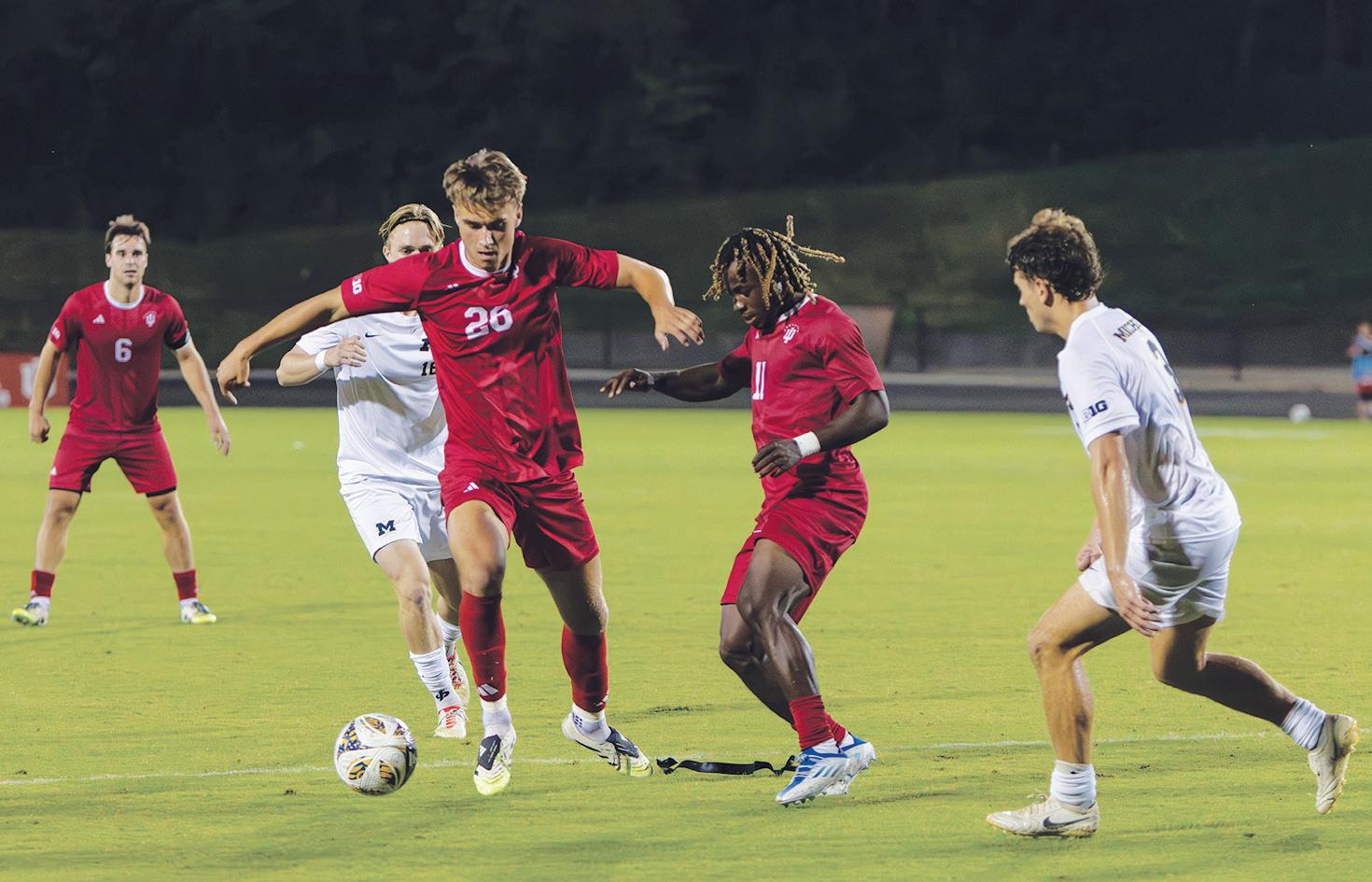
it could have given the Hoosiers the lead.
At the end of the match, Yeagley turned to his attacking options from the bench. Nesci, freshman forward Colton Swan and junior midfielder Jacopo Fedrizzi all got minutes with the intention of preventing a shutout, but the Hoosiers stayed goalless en route to their third loss of the season.
A week separates Indiana from its next conference
match — a bout against fellow 2024 Big Ten regular season champions Ohio State on Oct. 10. Seven days also separated the Hoosiers from their 4-2 win over UCLA on Sept. 26 to Oct. 3 night’s defeat, so time is on their side to fix any issues ahead of the game against the Buckeyes. If history tells any story, it’s that Indiana won’t lose to Ohio State — the Hoosiers haven’t suffered back-toback defeats in 192 straight games, dating back to Nov. 1, 2013. But Indiana also matched its largest conference loss total since 2021, and the road for the Hoosiers won’t get any easier. Only time will tell if the former No. 1 team in the nation can right the proverbial ship and secure a thirdstraight Big Ten regular season title — or if more pressing issues for postseason play await.
By Savannah Slone srslone@iu.edu | @savrivers06
For the first time since 2010, Indiana volleyball is ranked in the American Volleyball Coaches Association poll. The Hoosiers picked up wins in Los Angeles over thenNo. 17 USC on Oct. 3 and then-No. 24 UCLA on Oct. 4, pushing them to No. 20 in the rankings released Oct. 6. It marks the highest ranking in
The Hoosiers defeated USC and UCLA over two days
program history for Indiana.
The Hoosiers are off to their best Big Ten start since 1985, owning a 4-0 conference record. Eighthyear head coach Steve Aird and his squad sit at 13-1 on the season, with its lone loss coming in three sets to Western Kentucky University on Sept. 19.
After losing the first set 15-25 to the Trojans, the Hoosiers overcame early miscues to take the next
three sets and beat USC on Oct. 3. It was much of the same against the Bruins, with Indiana struggling to find its offensive rhythm and dropping the first set but finding a spark to win the final three sets. Following their losses, USC fell to No. 22 in the rankings, while UCLA dropped out of the rankings. The Hoosiers are now one of seven ranked Big Ten squads, with two others — Illinois and UCLA —
receiving votes in the poll. Indiana has the third best hitting percentage in the conference with a mark of .311. It is behind No. 7 Wisconsin and No. 1 Nebraska, which own hitting percentages of .333 and .327, respectively. Three Hoosiers rank in the top 20 in the Big Ten for total kills. Senior outside hitter Candela AlonsoCorcelles leads the team with 176 kills, ranking 13th
in the conference. Senior opposite hitter Avry Tatum and freshman outside hitter Jaidyn Jager have 173 and 165 kills, respectively. Tatum’s mark is tied for 15th, while Jager’s ranks 18th. Freshman setter Teodora Kričković was awarded Big Ten Freshman of the Week on Oct. 6 following her performance out west. The Novi Sad, Serbia, native collected 33 assists against USC and 44 assists and 10
digs against UCLA. She guided Indiana to a hitting percentage of .252 against the Trojans and .262 against the Bruins. With its new ranking, Indiana will travel to Michigan to take on Michigan and Michigan State. The Hoosiers will face the Wolverines at 7 p.m. Oct. 10 in Ann Arbor, Michigan, and the Spartans at 1 p.m. Oct. 12 in East Lansing, Michigan.
